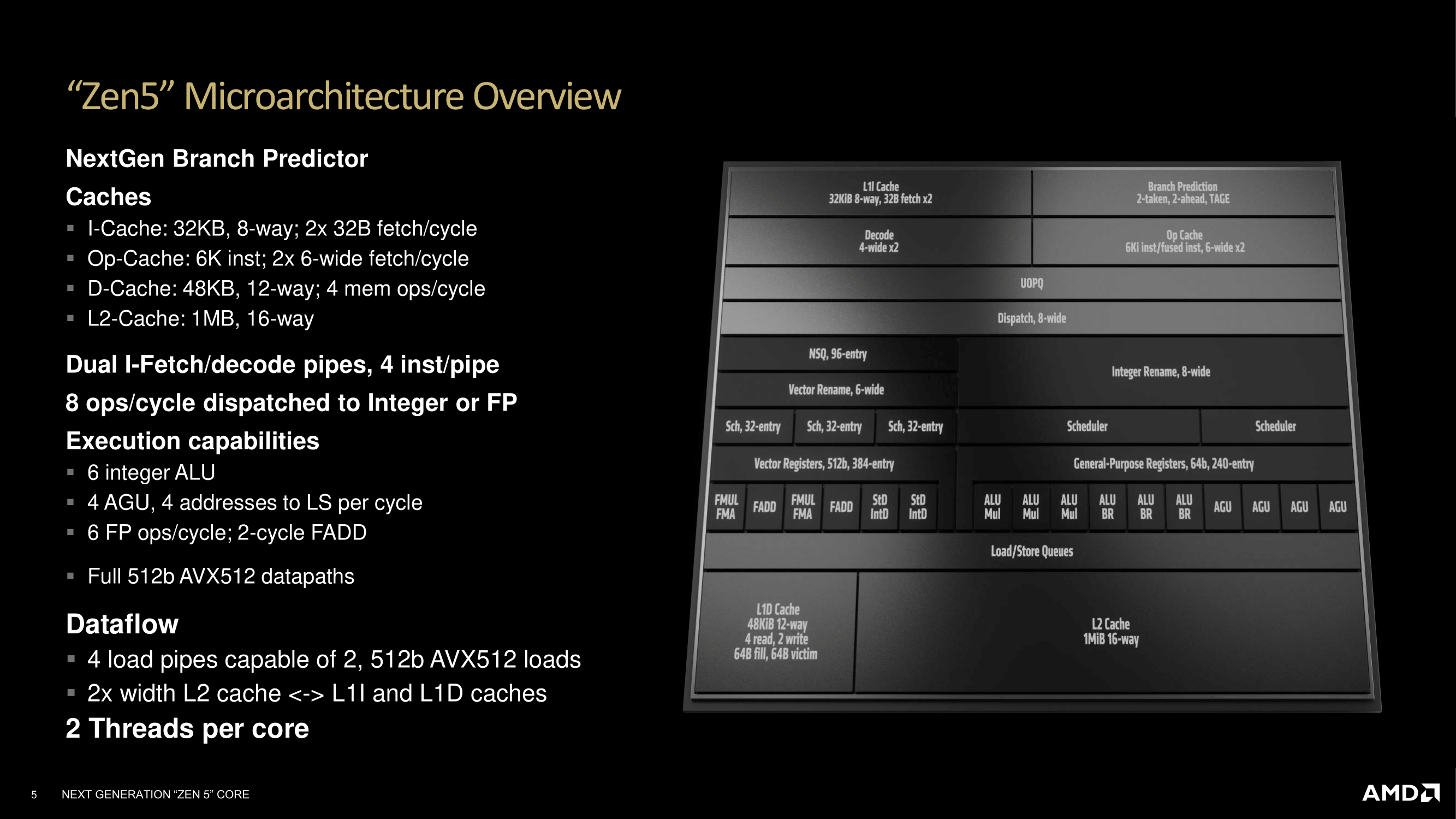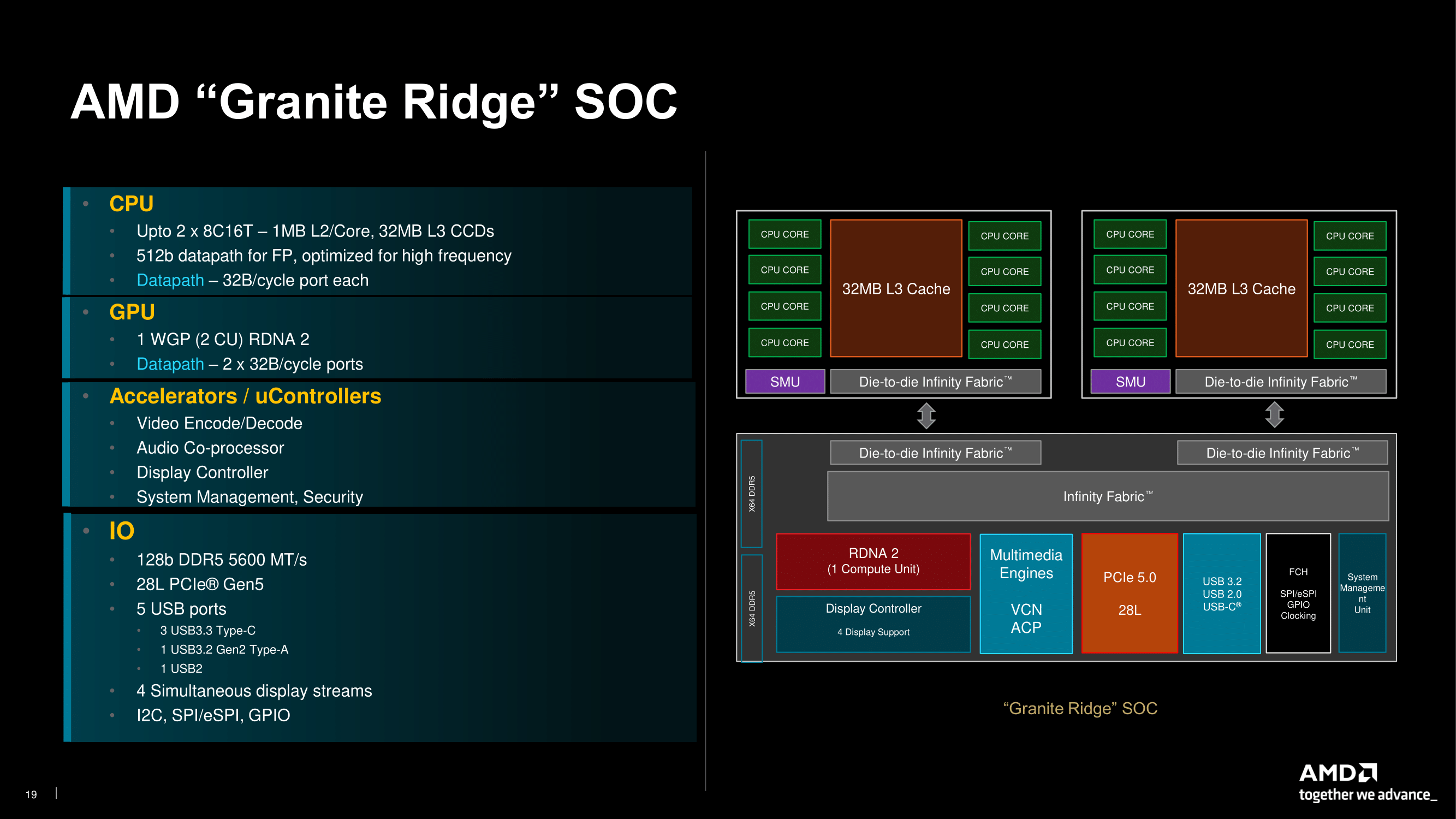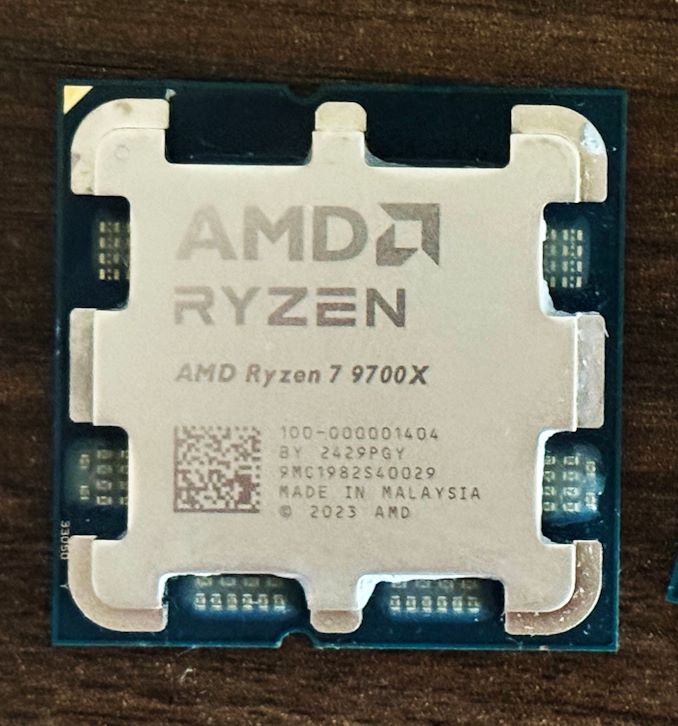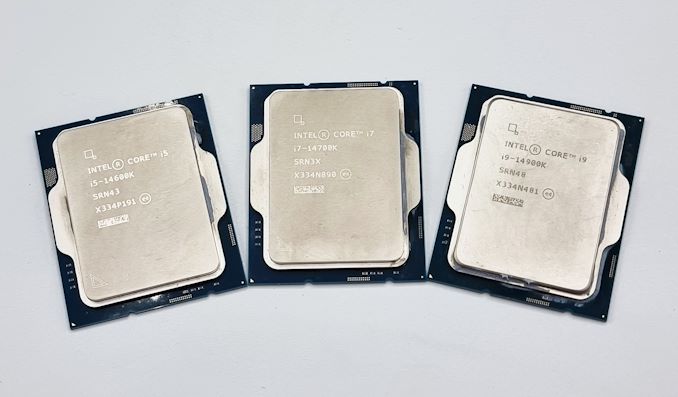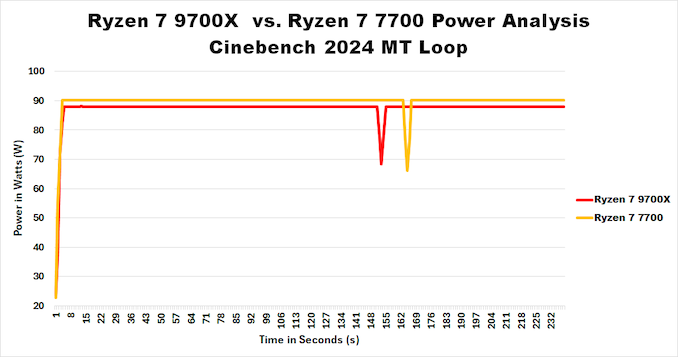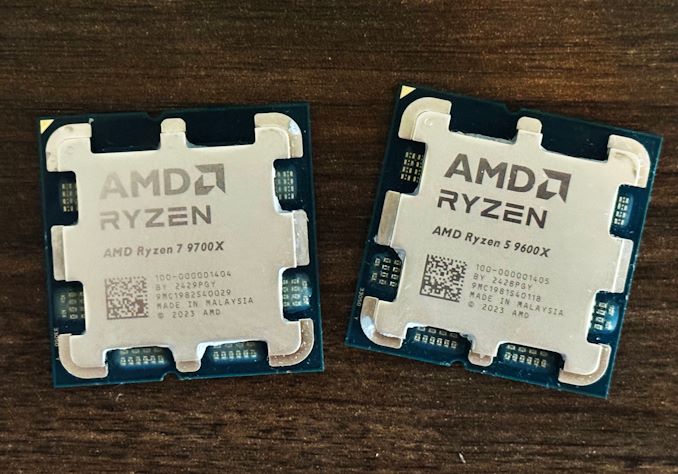
Original Link: https://www.anandtech.com/show/21493/the-amd-ryzen-7-9700x-and-ryzen-5-9600x-review
The AMD Ryzen 7 9700X and Ryzen 5 9600X Review: Zen 5 is Alive
by Gavin Bonshor on August 7, 2024 9:00 AM EST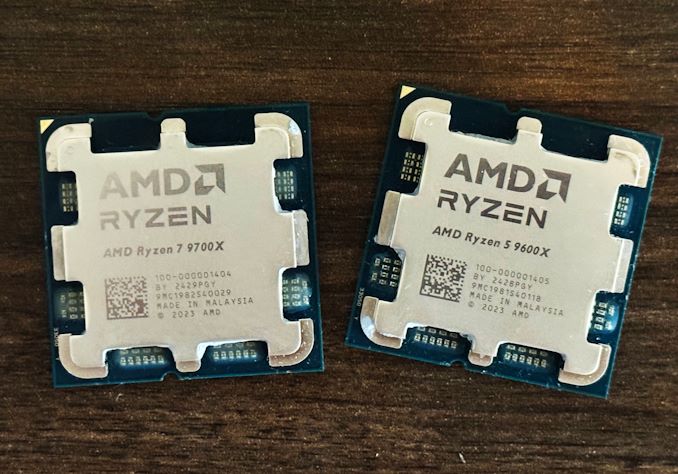
Last month, AMD launched their first processors using the Zen 5 microarchitecture for the mobile market via their Ryzen AI 300 series. Typically, with AMD Ryzen launches, we usually see the desktop parts come first, with the flagship model and then the mobile coming after. This time around, AMD has changed the dynamic of their release schedule with Zen 5 by launching the mobile chips first, which includes the Ryen AI 9 HX 370, which we reviewed last month. Today, Zen 5 on desktop has its turn, as AMD has launched two mid-range desktop processors, the Ryzen 7 9700X and the Ryzen 5 9600X.
AMD has launched two of the four announced Ryzen 9000 series processors today. The entry-level model is the Ryzen 5 9600X, a 6C/12T part with full-sized Zen 5 cores that can boost up to 5.4 GHz out of the box. The other model launched today is the Ryzen 7 9700X, which also features 8C/16T of Zen 5 and a boost clock speed of up to 5.5 GHz.
As part of AMD's push on platform longevity, the Ryzen 9000 series shares the same AM5 socket as its predecessor, meaning users can use X670E/X670 and B650E/B650 motherboards with a firmware update. We expected to see the newer X870X motherboards come with the Ryzen 9000 release, but unfortunately, these have been delayed.
So now we have Zen 5 in the form of the Ryzen 9000 series finally hitting the desktop, sans the top two SKUs, the Ryzen 9 9950X and Ryzen 9 9900X, which are coming later, it's time to see how much of an improvement Zen 5 is over Zen 4, not just in single-threaded but also multi-threaded workloads as AMD has promised up to an uplift of 16% IPC on average. The Ryzen 7 9700X and Ryzen 5 9600X have a TDP of 65 W, which we see as more aligned with the non-X SKUs, so it will be interesting to see how Zen 5 performs in both performance and efficiency.
AMD Ryzen 7 9700X and Ryzen 5 9600X: Zen 5 For Desktop
Over the last couple of months, since AMD unveiled Zen 5 at Computex 2024, we've penned quite several column inches around the latest Zen 5 microarchitecture. AMD has made some interesting upgrades to their Ryzen processors for Zen 5 when combined with Zen 4, at least in the design of the cores. Interestingly, AMD is using the same IOD that we saw in Zen 4, with the only part of the Ryzen 9000 series getting an upgrade via the cores themselves, with up to two core complexes (Ryzen 9) featuring the new Zen 5 cores. The I/O die itself is manufactured by TSMC on their 6 nm node.
The Zen 5 microarchitecture improves upon multiple areas over Zen 4, especially in things such as caching and instruction-fetch capabilities. The Zen 5 architecture doubles the L2 cache size to 1 MB per core over Zen 4, upgrading the I-Cache to 32 KB and the D-Cache to 48 KB. Dual I-Fetch/decode pipes allow the cores to handle more instructions per cycle than the single fetch/decode pipe featured on Zen 4. The Execution Units on Zen 5 also get a bit of a buff, as Zen 5 comes with 6 Integer ALUs and 6 FP operations per cycle versus the more minor execution capabilities of Zen 4. This way, the throughput and general efficiency of the chip are improved.
Zen 5 is also optimized for stronger data flow in general and power efficiency compared to Zen 4. It gets upgraded to 4 load pipes for 512b AVX-512 workloads, as well as wider L2 cache paths that should be able to handle data better. AMD has also taken a bit of a different approach with AVX-512 instructions for Zen 4, including a single full AVX-512 data path; however, two 256-bit paths come with Zen 4 and opt to "double pump" the data, which isn't as efficient. There is also the continued inclusion of Simultaneous Multi-Threading (SMT), which means Zen 5 has two threads per core for improving multi-threaded performance.
Another thing to note is that Zen 5 processors are manufactured using TSMC's N4P node. TSMC states that this offers significant improvements over the 5nm node used in Zen 4. Although TSMC's base 4nm node (N4) is not much better than 5nm, the N4P node reportedly shows plenty of gains in comparison. TSMC states that the N4P node delivers an 11% increase in performance, a 22% gain in power efficiency, and a 6% boost in transistor density compared to the N5 (5 nm) node. Thanks to more EUV layers, the N4P process also cuts production costs by using around 6%, with fewer masks used in the production stage.
AMD's Zen 5 die can support up to 16 cores, including 1 MB L2 cache per core, with up to 8C/16T of compute cores and 32 MB L3 cache per CCD. The integrated GPU uses 1 WGP and 2 CUs based on the RDNA 2 architecture, which remains unchanged over Zen 4. It also has two 32B/cycle ports for effective data management that offer basic integrated graphics support for users without a discrete graphics card. Other implementations on the Granite Ridge SoC include specific accelerators and micro-controllers for video encoding/decoding, audio co-processors, and display controllers with support for up to 4 concurrent displays.
The IO side supports 128-bit DDR5 memory at 5600 MT/s (DDR5-5600) and 28 x PCIe Gen 5 lanes, meaning it can support one full-length PCIe 5.0 slot at x16 or two full-length slots at x8/x8. It also gives additional PCIe headroom for PCIe 5.0 x4 M.2 SSDs. The SoC also supports multiple USB ports, including up to three USB 3.3 Type-C, one USB 3.2 Gen2 Type-A, and one USB2. We are starting to see a more holistic shift from the older USB standards, such as USB 2, although these are backward compatible throughout the different standards.
| AMD Ryzen 9000 Series Processors Zen 5 Microarchitecture (Granite Ridge) |
|||||||
| AnandTech | Cores / Threads |
Base Freq |
Turbo Freq |
L2 Cache |
L3 Cache |
TDP | MSRP |
| Ryzen 9 9950X | 16C / 32T | 4.3GHz | 5.7GHz | 16 MB | 64 MB | 170 W | $649 |
| Ryzen 9 9900X | 12C / 24T | 4.4GHz | 5.6GHz | 12 MB | 64 MB | 120 W | $499 |
| Ryzen 7 9700X | 8C / 16T | 3.8GHz | 5.5GHz | 8 MB | 32 MB | 65 W | $359 |
| Ryzen 5 9600X | 6C / 12T | 3.9GHz | 5.4GHz | 6 MB | 32 MB | 65 W | $279 |
Looking at the Ryzen 9000 stack as it currently stands, AMD has announced four SKUs in total so far. The flagship SKU, the Ryzen 9 9950X, has 16 cores, a max boost clock of up to 5.7 GHz, and 80 MB of cache, which is split between 64 MB for the L3 and 16 MB for the L2 (1 MB per core of L2). It also has a 170 W TDP, which mirrors the previous Ryzen 9 7950X. This is where the rest of the stack differs from the Ryzen 7000 SKUs, and each of the new Zen 5 chips replaced differs.
The Ryzen 9 9900X is a 12C/24T part, which boosts up to 5.6 GHz, which coincidentally is the same boost frequency the Ryzen 9 7900X it replaces comes with, too. Aside from the change in architecture to Zen 5 from Zen 4, the biggest difference in paper specifications is that the new Ryzen 9 9900X has a TDP of just 120 W, down from the 170 W from the previous SKU.
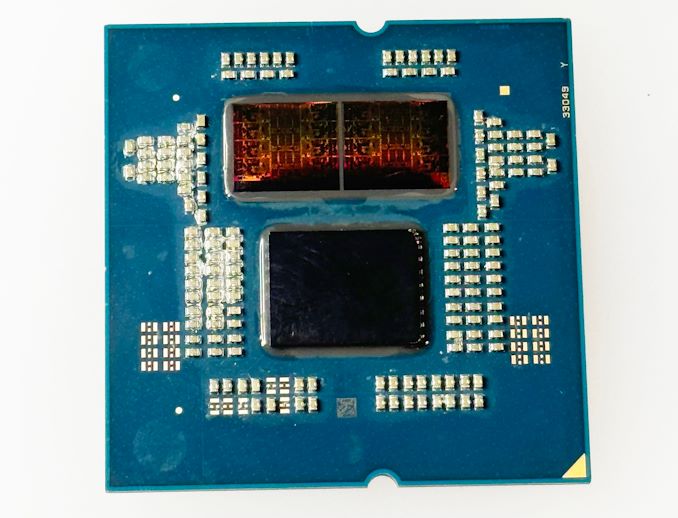
AMD Ryzen 9000 series die shot with 2 x CCXs (Ryzen 9)
Moving down the stack and onto the two processors we're reviewing today, the Ryzen 7 9700X, which comes with 8 cores, a max boost clock of up to 5.5 GHz, 32 MB of L3 cache, and a 65W TDP. In contrast, the Ryzen 5 9600X has just 6 cores, a max boost clock of up to 5.4 GHz, and 32 MB of L3 cache. Also, it has a 65 W TDP. Still, both their predecessors, the Ryzen 7 7700X (8C/16T Zen 4) and the Ryzen 5 7600X (6C/12T Zen 4), have a higher 105 W TDP.
This is a testament to AMD's focus and commitment to delivering power efficiency. With close to the same boost clocks as their Zen 4 counterparts, Zen 5 and Ryzen 9000 do things with a lower voltage/frequency (V/F) curve. This shows that Zen 5 is seemingly more efficient than Zen 4, but AMD has also bumped memory support up to DDR5-5600, up from DDR5-5200 on Ryzen 7000.
| AMD AM5 Chipset Comparison | |||||
| Feature | X870E | X870 | X670E | X670 | B650E |
| CPU PCIe (PCIe) | 5.0 | 5.0 | 5.0 | 4.0 | 5.0 |
| CPU PCIe (M.2 Slots) | At Least 1 PCIe 5.0 Slot | ||||
| Total CPU PCIe Lanes | 24 | ||||
| Chipset PCIe Lanes (Max) | 4.0: 12 3.0: 8 |
4.0: 8 3.0: 4 |
4.0: 12 3.0: 8 |
4.0: 8 3.0: 4 |
|
| USB4 | Mandatory (Discrete, Consumes 4 Chipset PCie 4.0 Lanes) |
Optional | |||
| SATA Ports (Max) | 8 | 4 | 8 | 8 | 4 |
| DDR5 Support | Quad Channel (128-bit bus) | ||||
| Wi-Fi | Wi-Fi 7 (Discrete) | Wi-Fi 6E (Discrete) | |||
| CPU Overclocking Support | Yes | ||||
| Memory Overclocking Support | Yes | ||||
| # of Chips | 2 | 1 | 2 | 2 | 1 |
| Silicon | ASMedia Promontory 21 | ||||
| Available | Expected Sept. 2024 | Expected Sept. 2024 | Sept. 2022 | Sept. 2022 | Oct. 2022 |
Although the Ryzen 9000 uses the same AM5 socket as the previous Ryzen 7000 series, motherboard vendors have been readying new motherboards based on the X870E and X870 chipsets. All of the AM5 socket motherboards that are either currently on the market or due to be released with the X870E/X870 chipsets use the same ASMedia Promontory 21 chipset at their heart. The only real difference is in the feature sets, and newer boards utilize new controllers that previously weren't available at the time.
Notable additions with X870E/X870 include USB 4.0 support, which will be ubiquitous on all X870(E) boards, where it was previously only optional for X670(E) series boards. X870(E) boards will also herald in Wi-Fi 7 support, although that's leaping from 6E with the 600 series with at least one PCIe 5.0 NVMe slot continuing to be a mandatory inclusion. AMD also notes that motherboards based on both platforms "feature 44 total PCIe lanes," which would break down to 24 lanes from the CPU and another 20 lanes from the chipset.
That being said, if users already have an existing AM5 motherboard, there's no need to upgrade unless the temptation of features like Wi-Fi 7 is pretty much the biggest difference on most of the newer motherboards. The other caveat with X870E and X870 is that there's no official date for these models to hit the shelves. We know these should be expected sometime in September, which we got from a reliable source from a big motherboard manufacturer.
Regarding pricing, the AMD Ryzen 7 9700X has an MSRP of $359, which is actually $40 cheaper than its predecessor, the Ryzen 7 7700X, which launched in September 2022 for $399. The same can be said about the Ryzen 5 7600X, which debuts at $279, which is $20 cheaper than the Ryzen 5 7600X did around this time 2 years ago at launch. AMD is coming in aggressive with its pricing on Zen 5. While both these chips are aimed firmly at the more affordable end of the market, it's time to see how they compete with their Ryzen 7000 (Zen 4) counterparts, as well as Intel's Raptor Lake (14th Gen) chips such as the Core i5-14600K, among others we've tested.
How does Zen 5 for desktop compare to Zen 4 and Intel's offerings? It's time to find out how Zen 5 hangs.
Test Bed and Setup
As per our processor testing policy, we take a premium category motherboard suitable for the socket, and equip the system with a suitable amount of memory running at the manufacturer's highest officially-supported frequency. This is also typically run at JEDEC subtimings where possible. It is noted that some users are not keen on this policy, stating that sometimes the highest official frequency is quite low, or faster memory is available at a similar price, or that the JEDEC speeds can be prohibitive for performance.
While these comments make sense, ultimately very few users apply memory profiles (either XMP or other) as they require interaction with the BIOS, and most users will fall back on JEDEC-supported speeds - this includes home users as well as industry who might want to shave off a cent or two from the cost or stay within the margins set by the manufacturer. Where possible, we will extend out testing to include faster memory modules either at the same time as the review or a later date.
The Current CPU Test Suite
For our AMD Ryzen 9000 testing, we are using the following test system:
| AMD Ryzen 9000 Series (Zen 5) System | |
| CPU | Ryzen 7 9700X ($359) 8 Cores, 16 Threads 65 W TDP Ryzen 5 9600X ($279) 6 Cores, 12 Threads 65 W TDP |
| Motherboard | ASRock X670E Taichi |
| Memory | SK Hynix 2x16 GB DDR5-5600B CL46 |
| Cooling | MSI MAG Coreliquid E360 360mm AIO |
| Storage | SK Hynix Platinum P41 2TB PCIe 4.0 x4 |
| Power Supply | MSI A1000G 1000W |
| GPUs | MSI NVIDIA RTX 4080 Gaming X Trio |
| Operating Systems | Windows 11 23H2 |
Our CPU 2024 Suite: What to Expect
We recently updated the CPU test suite to our 2023, but we've decided to update it again as we head into 2024. Our new suite has a more diverse selection of tests and benchmarks, focusing on real-world instruction sets and newer encoding and decoding libraries such as AV1, VP9, and HVEC. We have also included a range of AI-focused workloads and benchmarks, as we're seeing a direct shift from manufacturers to incorporate some form of on-chip AI processing, such as Ryzen AI and Intel's Meteor Lake AI NPU.
While we've kept some of the more popular ones, such as CineBench R23, we've added Maxon's latest CineBench 2024 benchmark to our test suite. We have also updated to the latest versions (at the time of incorporating the suite) in benchmarks such as Blender, V-Ray, and y-Cruncher.
With our processor reviews, especially on a new generational product such as AMD's Ryzen 9000 series, we also include SPEC2017 data to account for any increases (or decreases) to generational single-threaded and multi-threaded performance. It should be noted that per the terms of the SPEC license because our benchmark results are not vetted directly by the SPEC consortium, it is officially classified as an ‘estimated’ score.
We've also carried over some older (but still relevant/enlightening) benchmarks from our CPU 2023 suite. This includes benchmarks such as Dwarf Fortress, Factorio, Dr. Ian Cutress's 3DPMv2 benchmark, and Blender 3.6. We've also kept UL's Procyon office suite in as a more holistic system-wide, but we've omitted the AI suite as it's really nonsensical when not testing or utilizing NPUs.
As for gaming, we've updated our suite to include Company of Heroes 3, Cyberpunk 2077, F1 2023, Returnal, and Total War: Warhammer 3. We opt for a time-tested and similar methodology based on how we usually do things. This includes testing at 720p, 1080p, and 4K.
We've also taken the opportunity to update to NVIDIA's latest generation GeForce RTX 4080 video cards. And a big thank you to MSI for providing the Gaming X Trio cards we're using.
The CPU-focused tests featured specifically in this review are as follows:
Power
- Peak Power (y-Cruncher using AVX)
- Power analysis with Cinebench 2024
Office & Web
- UL Procyon Office: Various office-based tasks using various Microsoft Office applications
- JetStream 2.1 Benchmark: Measures various levels of web performance within a browser (we use the latest available Chrome)
- Timed Linux Kernel Compilation: How long it takes to compile a Linux build with the standard settings
- Timed PHP Compilation: How long does it take to compile PHP
- Timed Node.js Compilation: Same as above, but with Node.js
- MariaDB: A MySQL database benchmark using mysqlslap
Encoding
- WebP2 Image Encode: Encoding benchmark using the WebP2 format
- SVT AV1 Encoding: Encoding using AV1 at both 1080p and 4K, at different settings
- Dav1D AV1 Benchmark: A simple AV1 based benchmark
- SVT-HEVC Encoding: Same as SVT AV1, but with HEVC, at both 1080p and 4K
- SVT-VP9 Encoding: Same as other SVT benchmarks, but using VP9, both at 1080p and 4K
- FFmpeg 6.0 Benchmark: Benchmarking with x264 and x265 using a live scenario
- FLAC Audio Encoding: Benchmarking audio encoding from WAV to FLAC
- 7-Zip: A fabled benchmark we've used before, but updated to the latest version
Rendering
- Blender 3.6: Popular rendering program
- CineBench R23: The fabled Cinema4D Rendering engine
- CineBench 2024: The latest Cinema4D Rendering engine
- V-Ray: Another popular renderer
- POV-Ray: A persistence of ray-tracing benchmark
Science & Simulation
- y-Cruncher 0.8.2.9523: Calculating Pi to 5M digits, both ST and MT
- 3D Particle Movement v2.1 (Non-AVX + AVX2/AVX512)
- OpenFOAM: A Computational Fluid Dynamics (CFD) benchmark using drivaerFastback test case to analyze automotive aerodynamics.
- Dwarf Fortress 0.44.12: Fantasy world creation and time passage
- Factorio v1.1.26 Test: A game-based benchmark that is largely consistent for measuring overall CPU and memory performance
- 3D Mark CPU Profile: Benchmark testing just the CPU with multiple levels of thread usage
AI and Inferencing
- ONNX Runtime: A Microsoft developed open source machine learning and inferencing accelarator
- DeepSpeech: A Mozilla based speech-to-text engine benchmark powered by TensorFlow
- TensorFlow 2.12: A TensorFlow benchmark using the deep learning framework
We are currently using our new games from our 2024 suite, which has been long overdue. Our current games in our CPU testing and those featured in this review are as follows:
- Company of Heroes 3: 720p, 1080p, and 4K (both avg and 95% percentile)
- Cyberpunk 2077: 720p, 1080p, and 4K (both avg and 95% percentile)
- F1 2023: 720p, 1080p, and 4K (both avg and 95th percentile)
- Returnal: 720p, 1080p,and 4K (both avg and 95th percentile)
- Total War Warhammer 3: 720p, 1080p, and 4K (both avg and 95th percentile)
On Intel Woes & Raptor Lake Stability
Even though they're not the focus of today's review, there's no dancing around the subject of Intel's recent chip stability and longevity woes. The long-term stability of the company's high-end Raptor Lake silicon, used to power the 13th and 14th Generation Core desktop series, has come into question based on an increasing number of reports of initially stable chips becoming unstable months and years down the line. These complaints reached a crescendo earlier this year, kicking off a detailed investigation from Intel that is ultimately resulting in new microcode, new suggested motherboard settings, and an extended warranty for Intel's high-end desktop chips.
Intel has narrowed down the issue to “elevated operating voltages,” that at its heart, stems from a flawed algorithm in Intel’s microcode that requested the wrong voltage. The good news is that Intel will be able to resolve the issue of further damage through a new microcode update that will put an end to excessive voltage requests. Pending validation, this microcode is expected to be released in the middle of August.
From what we’re hearing, the performance impact of this microcode patch will be minimal-to-nonexistent. Though it goes without saying that it’s something we’ll want to validate ourselves.
In the meantime, however, that leaves Intel’s Raptor Lake desktop chips slowly singeing themselves to death ahead of the necessary microcode update. So what does this mean for our Ryzen review?
For the moment, we’re essentially in a holding pattern when it comes to Intel chips. While we are reasonably confident that Intel will be able to fix the problem with their microcode update later this month, we don’t know what the performance impact will be. And while it’s incredibly unlikely anyone will be able to toast a new Raptor Lake chip in the span of just a couple of weeks, we cannot in good consciousness recommend buying Intel’s high-end Raptor Lake chips until that microcode update is available.
But this problem will eventually get fixed. And in the meantime, we need to provide some kind of performance comparison for the Ryzen 9000 chips against both AMD’s previous-generation parts, as well as AMD’s competitors (spoiler: AMD is already winning, so pulling Intel’s chips now doesn’t do them any favors). Consequently, we’ve decided to include Intel’s chips anyhow, which are being marked with the classic and time-honored anomalous data symbol, the asterisk, to indicate that these are results from unfixed chips.
Hopefully, you’ll agree that this is a fair way to include the data for Intel’s chips so that we can compare their performance, while acknowledging that performance could very well change for the worse here in a matter of weeks.
Microcode fixes aside, there’s also one other change we’re making with Intel chips going forward. Which, although coming from the shadow of a major chip stability scandal, is something we’ve been wanting Intel to address for years now: stock power limits.
As part of their investigation into the Raptor Lake stability issue, Intel finally took their motherboard partners to task for shipping their motherboards with ridiculous out-of-the-box power settings. These elevated settings essentially allowed Intel’s chips to run in their highest boost state at all times, power consumption be damned. Which makes for great benchmarks, but a poor user experience overall when those chips are drawing 400 Watts of power.
The end result of those efforts is that Intel has published official guidance for power settings for motherboard vendors and users alike to follow. These “Intel Default Settings” are Intel’s formal recommendation for BIOS default power settings, and while Intel isn’t forcing anyone to use them, they are strongly encouraging everyone to use them.
The settings, overall, are very reasonable. And ideally, how Intel motherboards should have been shipping all along. This includes keeping current limits and other protective measures enabled, enabling enhanced Thermal Velocity Boost (eTVB), and actually following the TDP guidelines for Intel’s chips.
Intel’s default settings also include multiple potential power delivery profiles. These align mostly to the capabilities of the motherboard, reflecting the fact that high-end boards are typically specifically engineered to allow for higher TDP and current limits. To that end, Intel’s recommendation is always to use the highest profile a board/chip combo can support – Performance for 600K and 700K processors, and Extreme for 900K chips. All settings still adhere to Intel’s PL2 power limits, but Extreme allows for higher currents still, and higher power limits on Intel’s ridiculously binned KS processors.
Going forward, our testing with Intel processors will be following the Intel Default Settings. This means we’ve reined in our Intel chips a bit so that their power consumption is a bit more down to earth, but so is their performance. Though this also means that our Intel performance results going forward are not comparable to previous data; we’re wiping the board and starting from scratch.
Ultimately, this is being done in accordance with our longstanding policy to prefer testing hardware as it operates out of the box, without overclocking or other warrany-breaking changes. Now that Intel (finally) has a proper and reasonable set of default motherboard power settings, we are going to make sure our testing adheres to them, just as we do other default settings.
Power Consumption
Our previous sets of ‘office’ benchmarks have often been a mix of science and synthetics, so this time, we wanted to keep our office and productivity section purely based on real-world performance. We've also incorporated our power testing into this section.
The biggest update to our Office-focused tests for 2024 and beyond includes UL's Procyon software, the successor to PCMark. Procyon benchmarks office performance using Microsoft Office applications, with other web-based benchmarks such as Jetstream and timed runs of compilers, including Linux, PHP, and Node.js.
Below are the settings we have used for each platform:
- DDR5-5600B CL46 - Ryzen 9000
- DDR5-5600B CL46 - Intel 14th & 13th Gen
- DDR5-5200 CL44 - Ryzen 7000
Power
The nature of reporting processor power consumption has become, in part, a bit of a nightmare. Historically the peak power consumption of a processor, as purchased, is given by its Thermal Design Power (TDP, or PL1). For many markets, such as embedded processors, that value of TDP still signifies the peak power consumption. For the processors we test at AnandTech, either desktop, notebook, or enterprise, this is not always the case.
Modern high-performance processors implement a feature called Turbo. This allows, usually for a limited time, a processor to go beyond its rated frequency. Exactly how far the processor goes depends on a few factors, such as the Turbo Power Limit (PL2), whether the peak frequency is hard coded, the thermals, and the power delivery. Turbo can sometimes be very aggressive for TDP that are, broadly speaking, applied the same. The difference comes from turbo modes, turbo limits, turbo budgets, and how the processors manage that power balance. These topics are 10000-12000 word articles in their own right, and we’ve got a few articles worth reading on the topic.
- Why Intel Processors Draw More Power Than Expected: TDP and Turbo Explained
- Talking TDP, Turbo and Overclocking: An Interview with Intel Fellow Guy Therien
- Reaching for Turbo: Aligning Perception with AMD’s Frequency Metrics
- Intel’s TDP Shenanigans Hurts Everyone
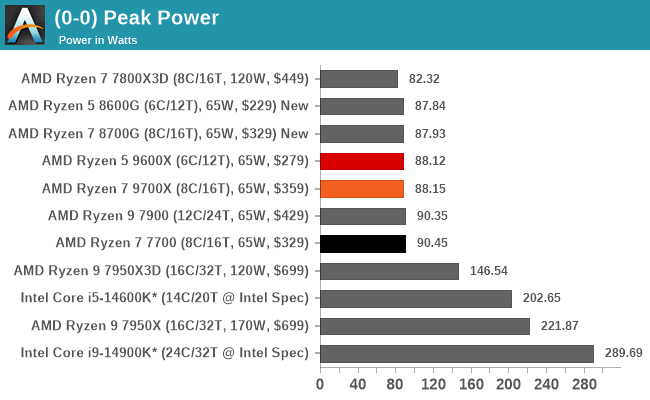
Regarding peak power consumption, all of AMD's 65 W TDP designated chips fall between 87 and 88 W due to AMD's Package Power Tracking from the CPU socket itself (PPT), which boosts power for more performance. It is misleading regarding what the CPU is pulling power-wise compared to what the TDP states, but there are very few examples of any processor in the modern age following TDP.
Looking at how the AMD Ryzen 7 9700X compares to the previous Ryzen 7 7700, we can see both perform similarly regarding power consumption. Both chips, when loaded up with the Cinebench 2024 multi-threaded test, consistently tread between 88 W (9700X) and 90 W (7700). Power variation within the workload itself is very consistent, with very little differential as the workload progresses through the loop. Between the tests loading, we can see a consistent drop in power to just under 70 W briefly for the Ryzen 7 9700X and around 67 W for the Ryzen 7 7700. Given that both processors are nearly identical (8C/16T at 65 W TDP/88-90 W PPT), aside from the underlying core architecture, we can see striking similarities in power consumption and behavior under an intensive workload, too.
SPEC CPU 2017 Performance
SPEC CPU 2017 is a series of standardized tests used to probe the overall performance between different systems, different architectures, different microarchitectures, and setups. The code has to be compiled, and then the results can be submitted to an online database for comparison. It covers a range of integer and floating point workloads, and can be very optimized for each CPU, so it is important to check how the benchmarks are being compiled and run.
We run the tests in a harness built through Windows Subsystem 1 for Linux, developed by Andrei Frumusanu. WSL1 has some odd quirks, with one test not running due to a fixed stack size, but for like-for-like testing it is good enough. Because our scores aren’t official submissions, as per SPEC guidelines we have to declare them as internal estimates on our part.
For the launch of the Ryzen 9000 desktop chips, we've built a fresh set of binaries to better take advantage of the Zen 5 architecture. Specifically, as these are the first consumer chips since 2021's Rocket Lake (11th Gen Core) to offer AVX-512 support with a full, 512-bit wide SIMD backing it, we've built a new set of binaries to make use of the feature.
For compilers, we use LLVM/Clang for the C/C++ tests, and for Fortran tests we’re using GCC's GFortran. Ont he whole, LLVM offers better cross-platform comparisons, especially to platforms that only have LLVM support. However LLVM's modern Fortran compiler, LLVM Flang (aka Flang-new), is not production ready, whereas GFortran is. As always, we’re not considering closed-source compilers such as MSVC or ICC.
clang version 18.1.8
gfortran version 14.2.0
-Ofast -fomit-frame-pointer
-march=[x86-64-3 or x86-64-4, depending on chip's supported ISA]
Our compiler flags are straightforward, with basic –Ofast and relevant ISA switches. Because it's not possible to build a single set of binaries that offer AVX-512 support while still gracefully falling back to AVX2 on platforms that lack the feature, we're technically running two sets of binaries on x86 platforms. AVX-512 processors get binaries compbiled with the -march=x86-64-4 flag, while all other x86 platforms get -march=x86-64-3. And note that while scores are similar overall, the results from these new binaries are not comparable to our previous binaries, due to the significant compiler changes in the last few years.
To note, the requirements for the SPEC license state that any benchmark results from SPEC have to be labeled ‘estimated’ until they are verified on the SPEC website as a meaningful representation of the expected performance. This is most often done by the big companies and OEMs to showcase performance to customers, however is quite over the top for what we do as reviewers.
Single-Threaded (Rate-1) Results
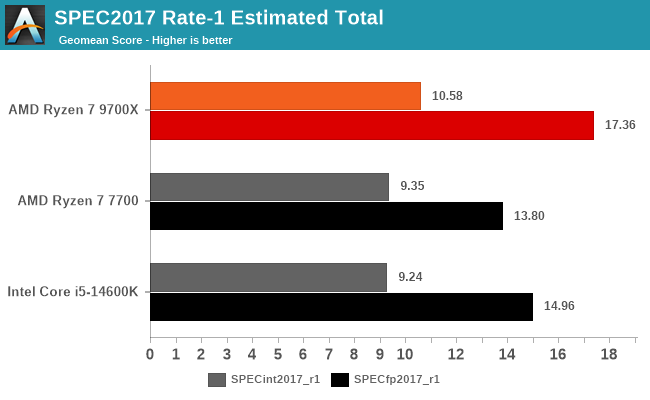
With the new binaries, we've not yet had time to run the much longer multithreaded Rate-N tests, so for today's launch all we have is single-threaded results. Which is fine in this case, as we're primarily using SPEC as a means of evaluating IPCs and core architectural improvements.
And starting at a high level with the geomean scores, things look good for AMD's latest chip architecture. Even though we've already taken a preliminary look at Zen 5 with the Ryzen AI 300 launch last week, looking at the desktop chips gives us much more of a focused comparison, since the underlying AM5 platform hasn't changed from the Ryzen 7000 generation. Other than supporting slightly faster memory (DDR5-5600 vs DDR5-5200), the Ryzen 7 9700X and Ryzen 7 7700 are about as close as can be. The only thing keeping this from being strictly an IPC comparison is that the 9700X is clocked a bit higher, at 5.5GHz versus the 5.3GHz of the 7700 (a 3.8% advantage).
The actual performance advantage we find is easily in Zen 5's favor. Whereas the Zen 4 based Ryzen 7 7700 barely edged out the Core i5-1400K in integer performance, and trailed it in floating point performance, the Zen 5 Ryzen 7 9700X is ahead on all fronts. AMD's chip is a generation newer, and it certainly shows here.
By the numbers, the performance uplift in SPEC CPU 2017 over the 7700 is 13.2% for integer performance, and an impressive 25.8% for floating point performance. This is a greater uplift in both integer and floating point performnace than we saw with the mobile chips; the desktop chips show a distinct integer performnace improvement, and the floating point performance gains are even greater than before. In our preview piece, we theorized that Zen 5 is going to provide a greater floating point performance uplift than it will integer performance, and this seems to be validated by our benchmark results here.
We've not yet had the chance to run our x86_64-v3 (non-AVX-512) binaries on AMD's chips, so I won't speculate too much on the impact of a 512-bit SIMD in these scores. But the SPEC CPU benchmark suite is not known for being particularly sensitive on SIMD width to begin with, as it uses plenty of serial code.

Looking at the individual integer sub-test scores, we find a near-consistent performance improvement for the 9700X. With the exception of stubborn 505.mcf, the Zen 5 chip is always improving on its predecessor. The biggest gains coming in 500.perlbench, 525.x264, and the Forfran-focused 548.exchange2. Overall, the sub-tests tend to cluster in to two groups: about half the tests show minimal performance uplift, and the other half show extensive performance uplifts. This reflects the wide variety of workloads used by the sub-tests, and how not every workload is going to extensively benefit from AMD's architectural advances.
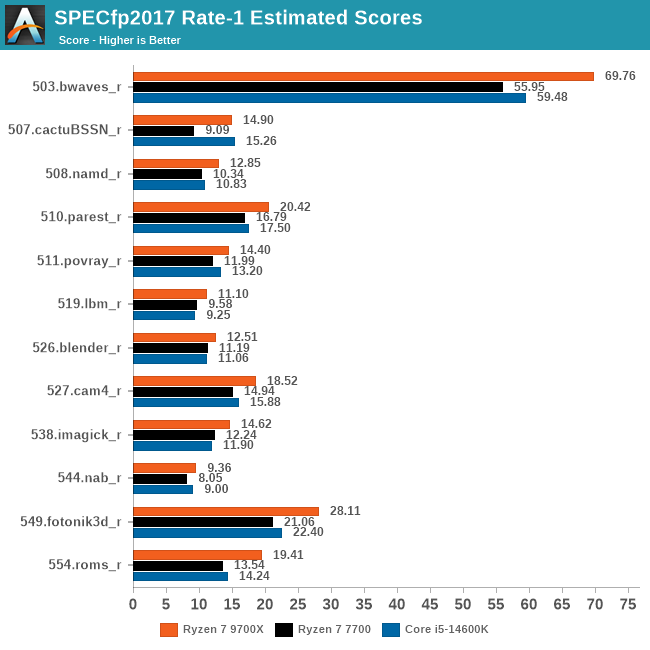
Coming from our geomean averages, where we saw that the 9700X beat the 7700 by 25%, looking at our individual scores we can see that AMD has significantly improved their floating point performance across virtually the entire board. Not only does the 9700X cleanly beat the 7700 in every last test here, but no sub-test score improves by less than 10%. So based on these results, there's little reason not to expect virtually all floating point workloads to benefit similarly.
The only caveat to improved floating point performance is that it's not as applicable to day-to-day productivity workloads, which historically are integer dominated. On the flip side, however, games are traditionally FP-bound, so Ryzen 9000's gaming performance should prove very interesting.
In the meantime, we'll bave updating this section later on this week with SPEC Rate-N (multi-threaded) results once those benchmarks have completed.
Productivity and Web
Our previous sets of ‘office’ benchmarks have often been a mix of science and synthetics, so this time, we wanted to keep our office and productivity section purely based on real-world performance. The biggest update to our Office-focused tests for 2024 and beyond includes UL's Procyon software, which is the successor to PCMark. Procyon benchmarks office performance using Microsoft Office applications, and we've thrown in some timed compiler benchmarks such as Node.js, Linux, and PHP.
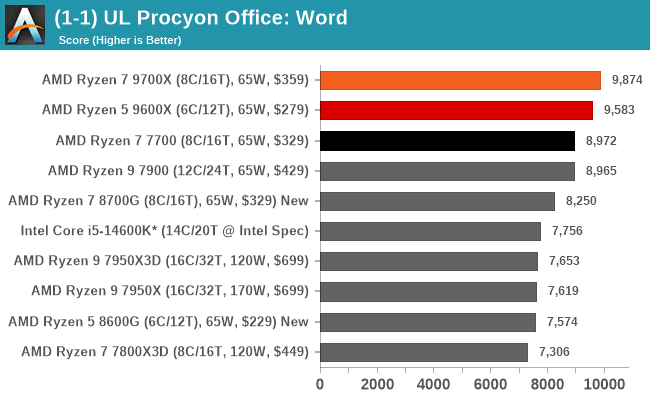
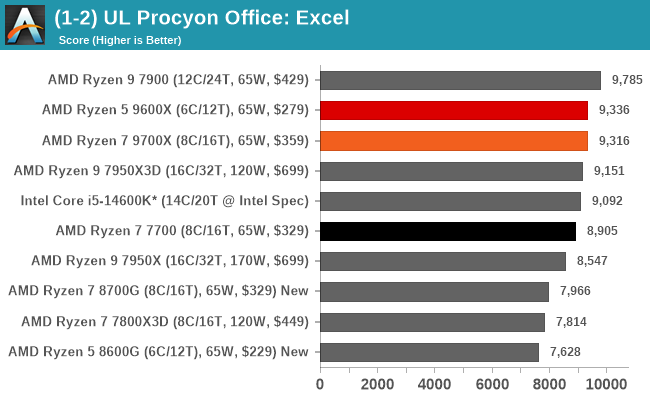
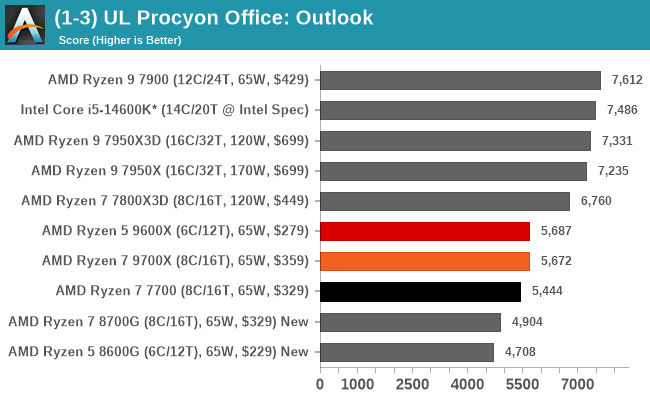

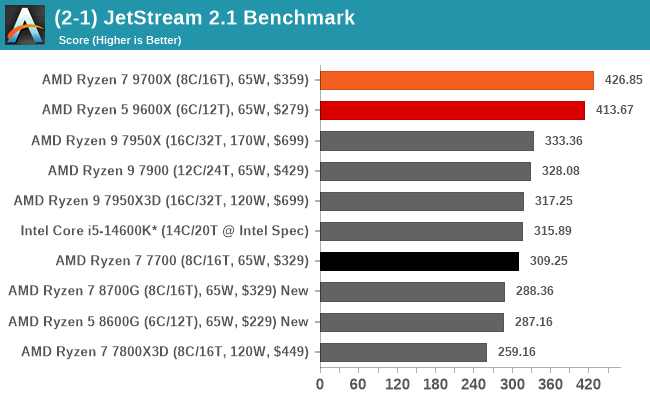
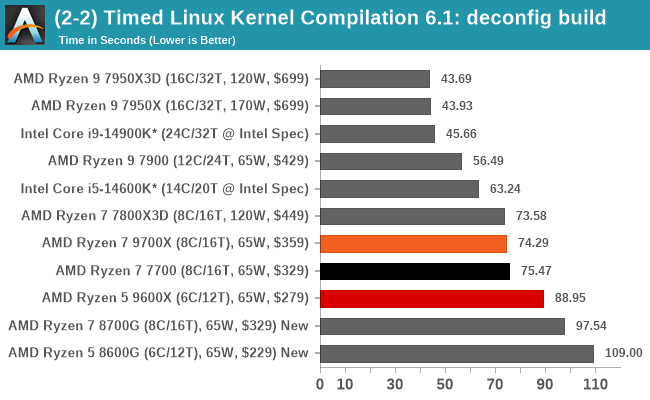
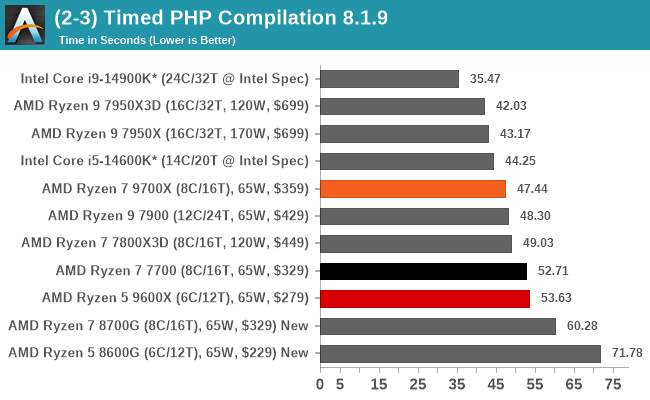
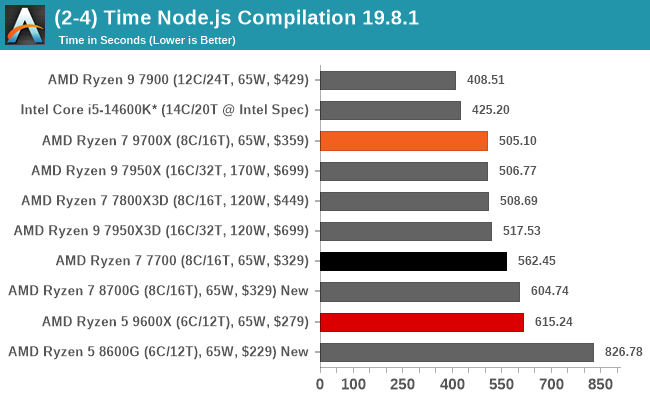

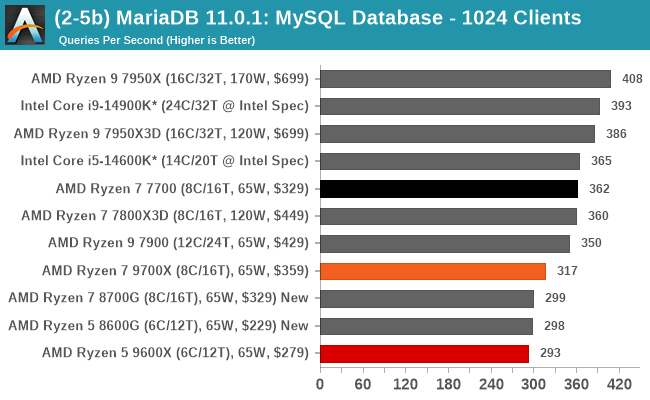
In the productivity section of our CPU suite for 2024, all of the desktop chips tested perform similarly in the UL Procyon office-based benchmarks, which use Microsoft Office and is an everyday piece of software most people will use, especially in a work or study-based setting. The benchmark where the Zen 5 chips seem to make an impact is in the Jetstream 2.1 web-based benchmark, which puts both the Ryzen 7 9700X and the Ryzen 5 9600X ahead of the competition comfortably.
CPU Benchmark Performance: Encoding
One of the interesting elements of modern processors is encoding performance. This covers two main areas: encryption/decryption for secure data transfer and video transcoding from one video format to another.
In the encrypt/decrypt scenario, how data is transferred and by what mechanism is pertinent to on-the-fly encryption of sensitive data—a process that more modern devices are adopting to improve software security.
We've updated our list of encoding benchmarks for our 2024 CPU suite to include some of the most relevant and recent codecs, such as AV1 and HEVC. Not only this, but we have also WebP2 image encoding into the mix to show not only how the latest processors perform with these codecs but also to show discrepancies in performance throughout the different segments.
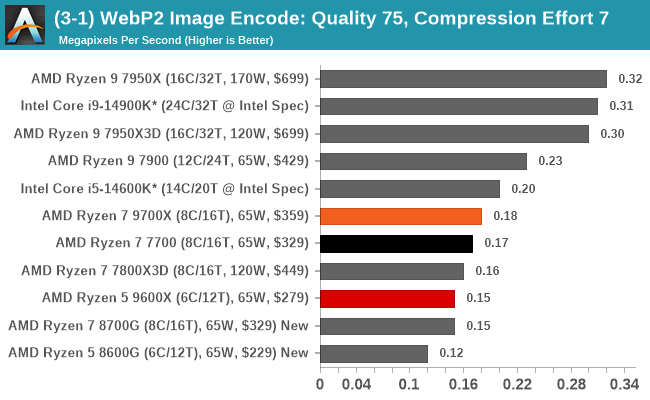
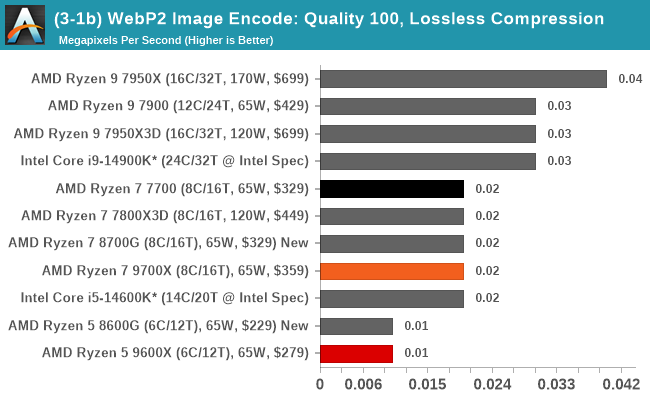
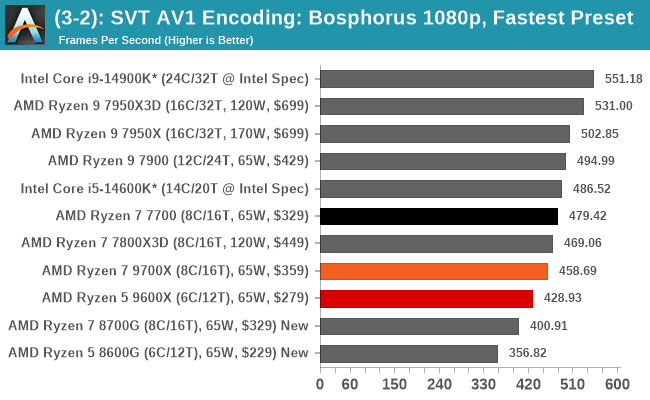
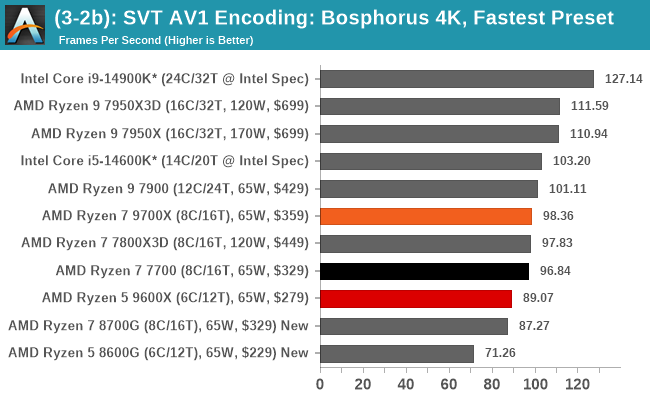
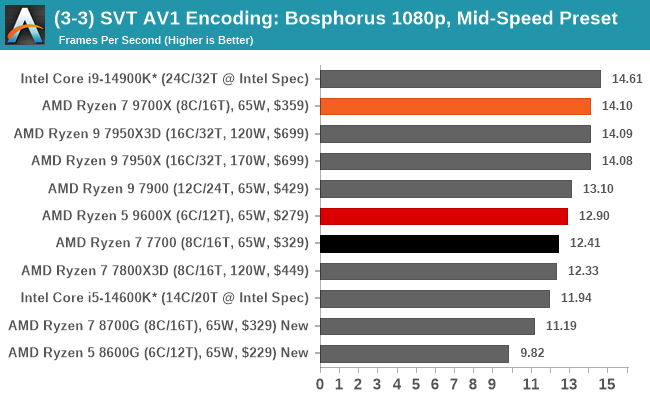
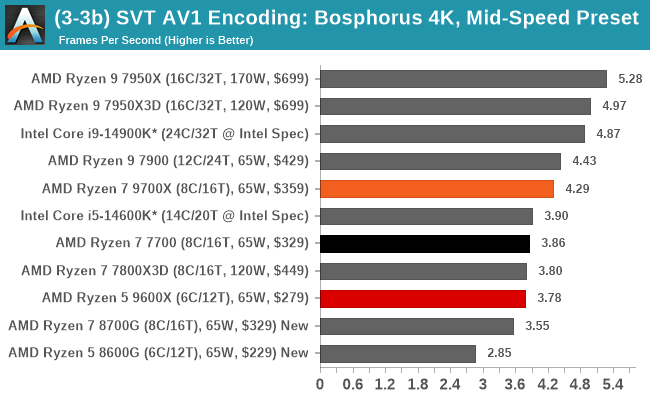
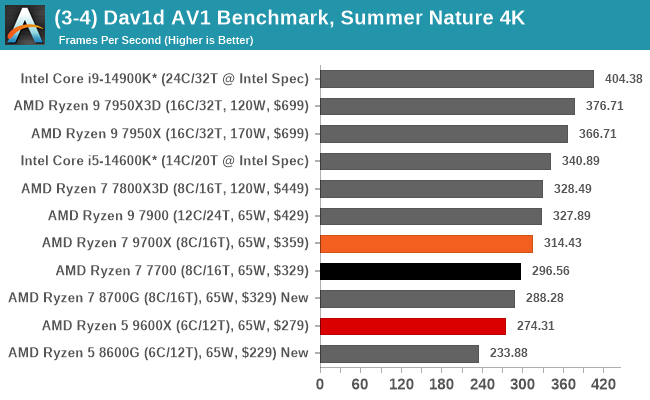
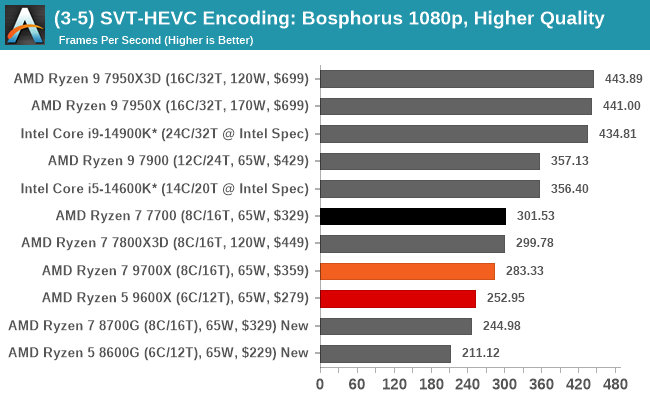
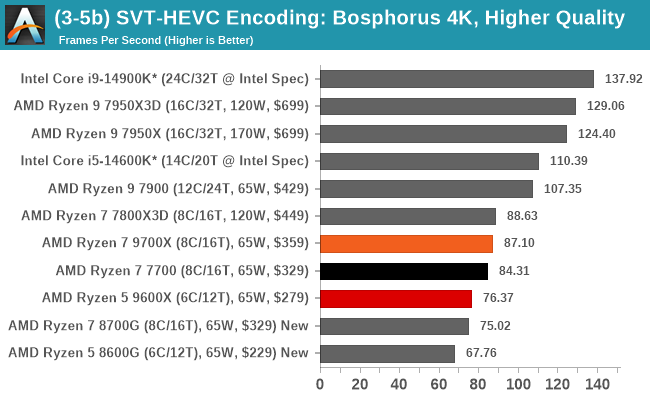

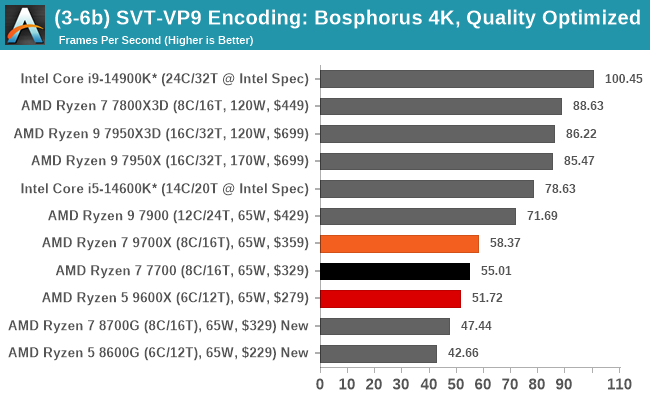
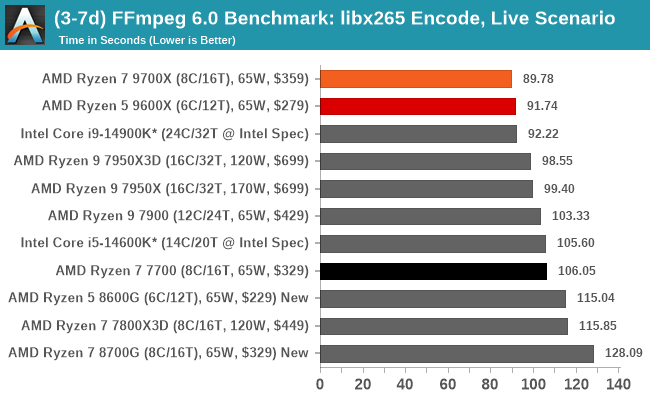
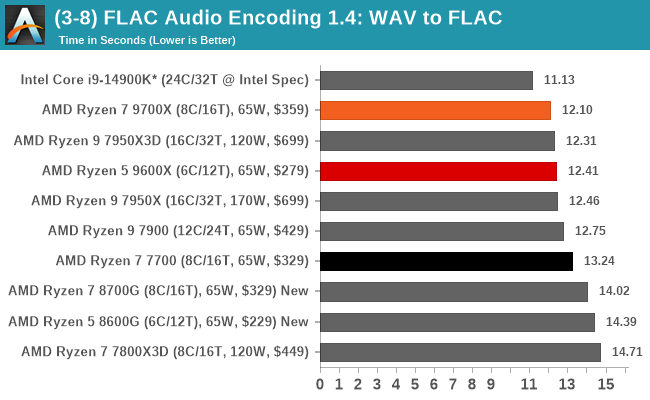
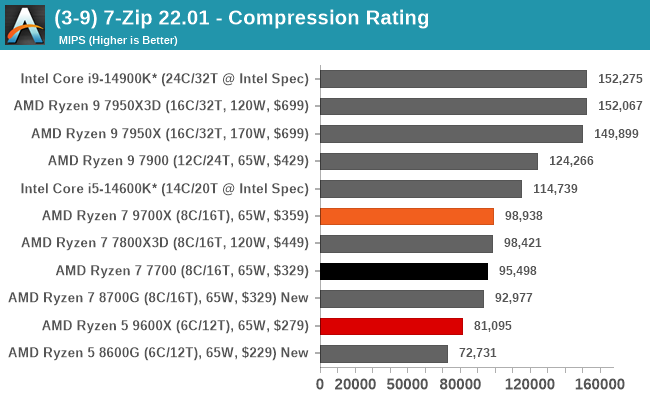
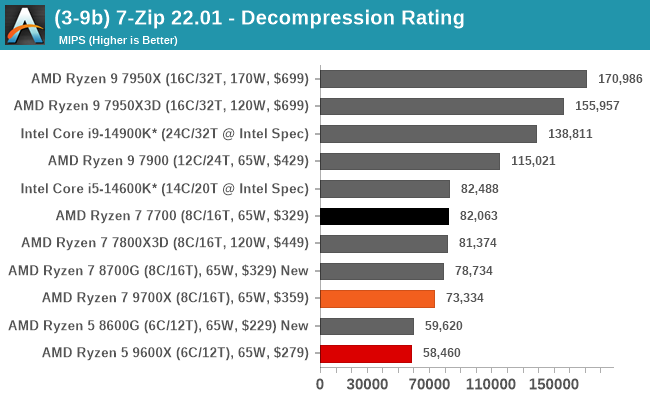
When it comes to encoding performance, there are as many wins for Zen 5 as there are losses. In our 7-Zip compression and decompression benchmark, Zen 5 doesn't really deliver compared to the other chips on test. In our FFMPEG encoding test, Zen 5 performs well, while in our FLAC audio encoding benchmark, the Ryzen 7 9700X only loses out to Intel's flagship Core i9-14900K, which is no loss in reality. In our AV1 encoding benchmarks, Zen 5 is competitive, but it doesn't give anything extra when compared to the competition.
CPU Benchmark Performance: Rendering & Simulation
Rendering tests, compared to others, are often a little more simple to digest and automate. All the tests put out some sort of score or time, usually in an obtainable way that makes it fairly easy to extract. These tests are some of the most strenuous in our list, due to the highly threaded nature of rendering and ray-tracing, and can draw a lot of power.
If a system is not properly configured to deal with the processor's thermal requirements, the rendering benchmarks are where it would show most easily as the frequency drops over a sustained period of time. Most benchmarks, in this case, are re-run several times, and the key to this is having an appropriate idle/wait time between benchmarks to allow temperatures to normalize from the last test.
Also in this section are our simulation-based tests, including our typical gaming simulation benchmarks, which consist of our Dwarf Fortress and Factorio benchmarks.
Rendering
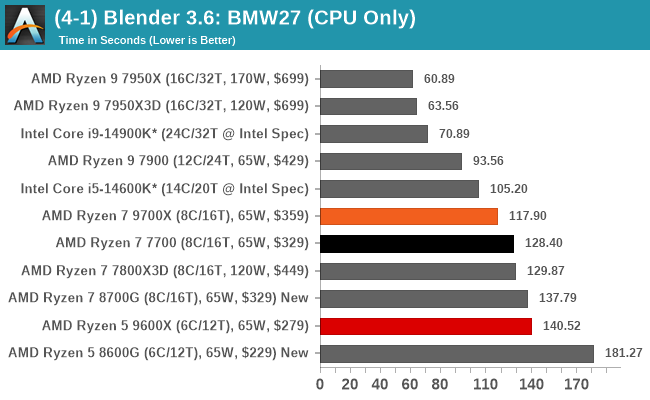
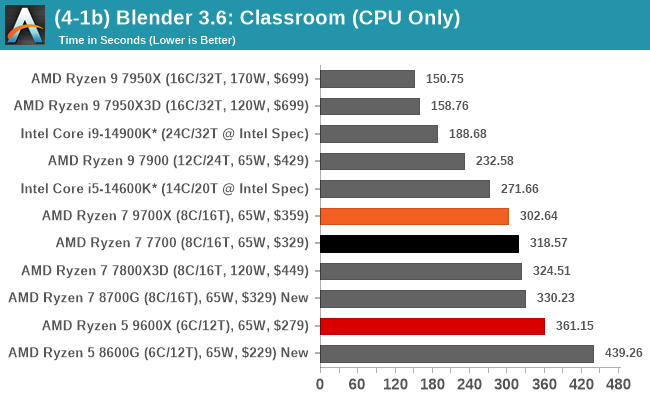
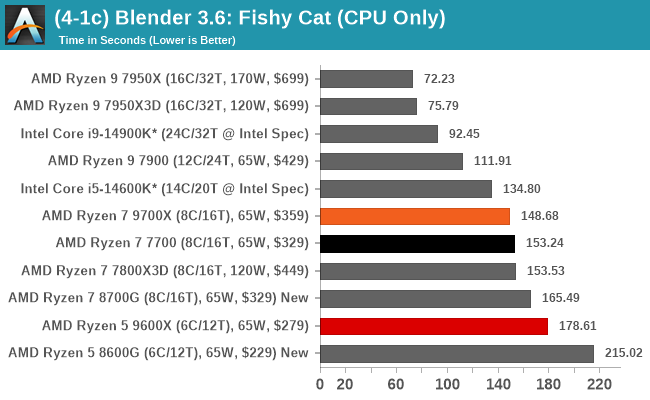
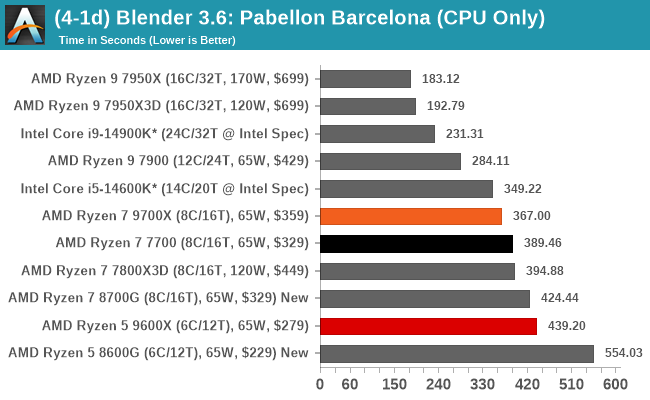
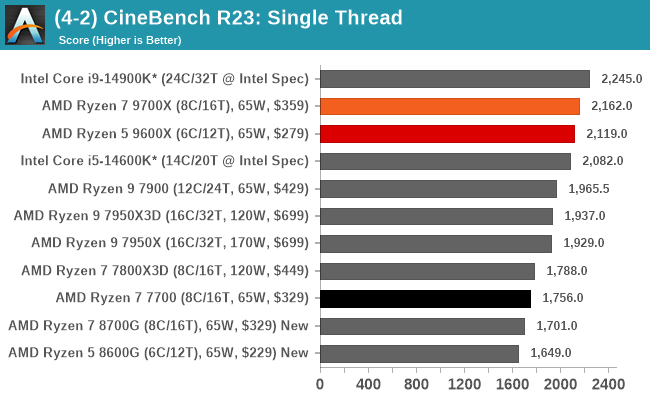
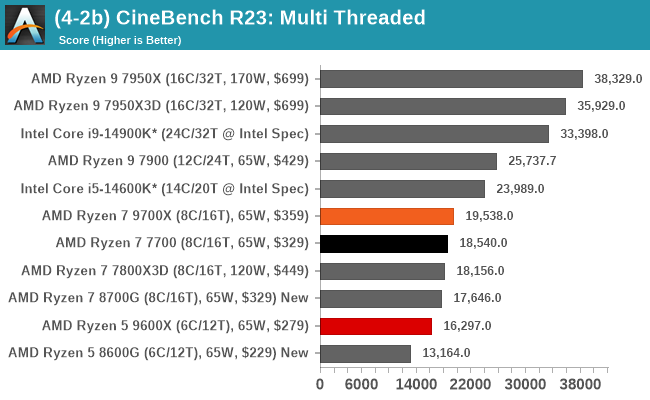

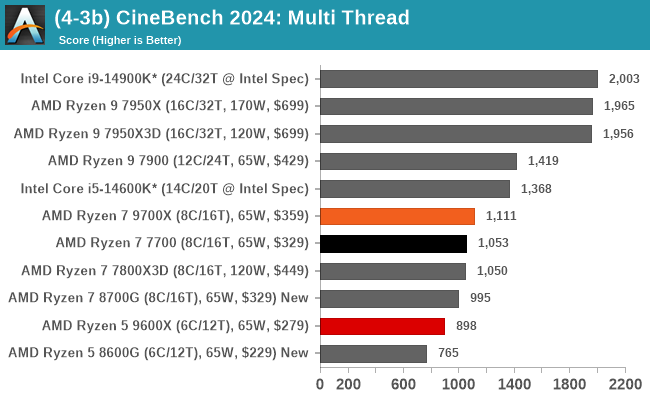
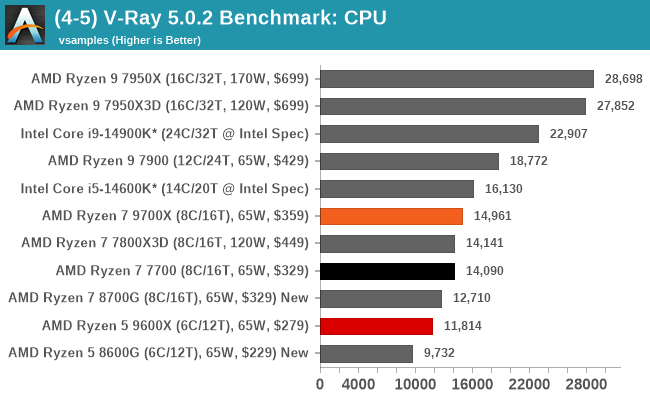
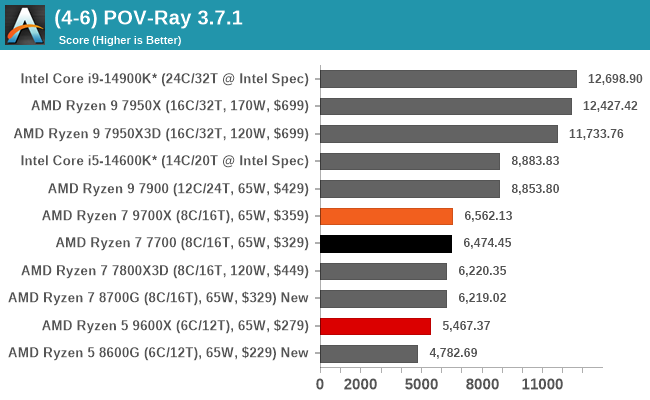
In rendering, especially in single-threaded scenarios, Zen 5 does have an advantage over Zen 4, especially in both iterations of Cinebench. Multi-threaded performance over Zen 4 core for core, so the Ryzen 7 9700X vs the Ryzen 7 7700m, there's really not much in it at all. Zen 5 wins single-threaded, but in multi-threaded workloads that aren't AVX-512 enabled, then there's no major difference.
Simulation
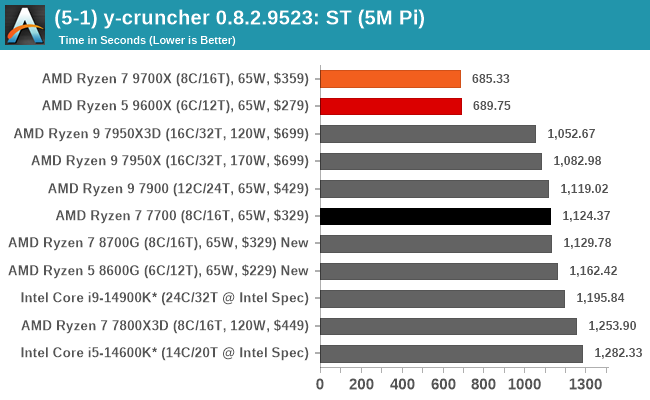

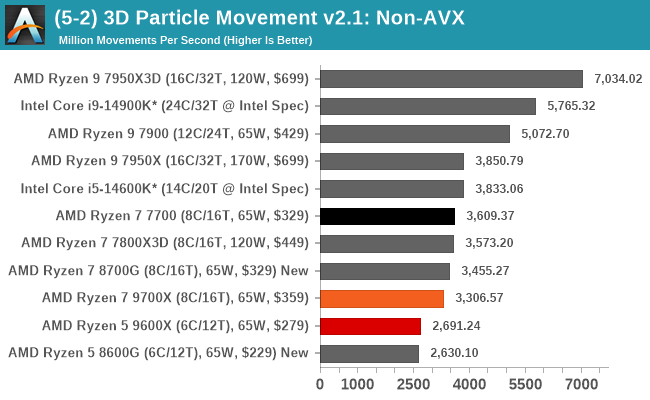
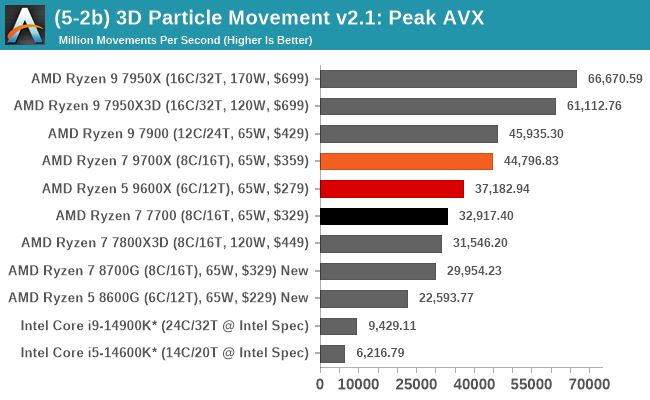
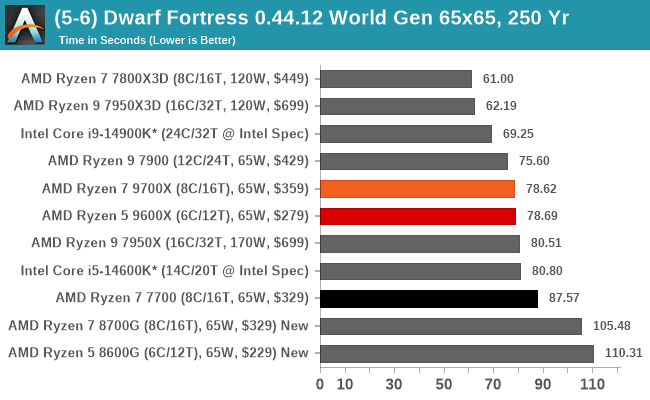
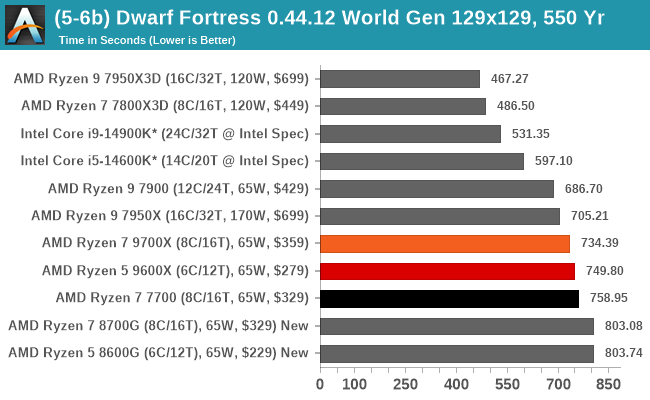
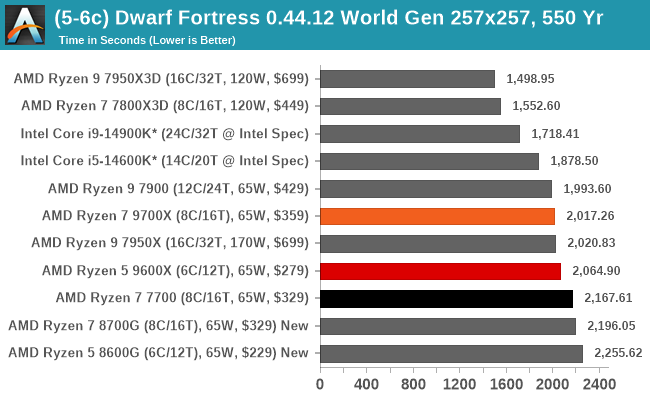
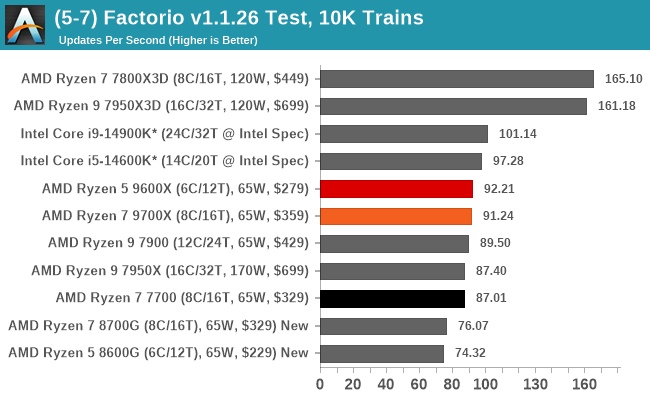

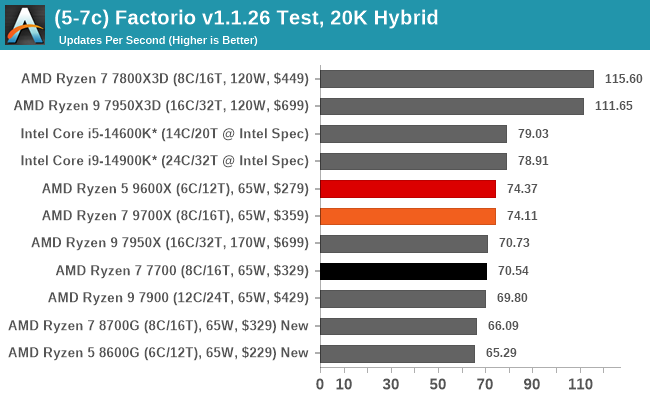

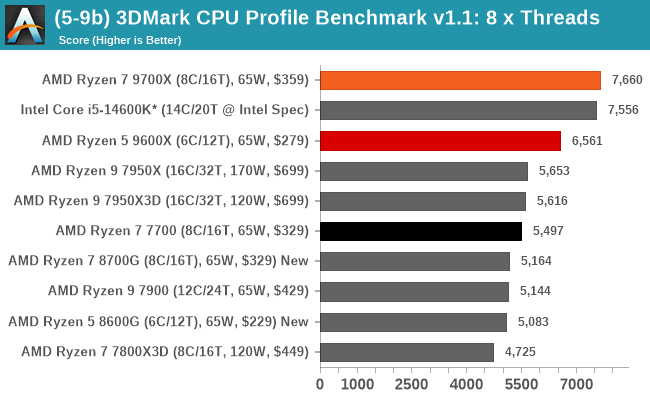
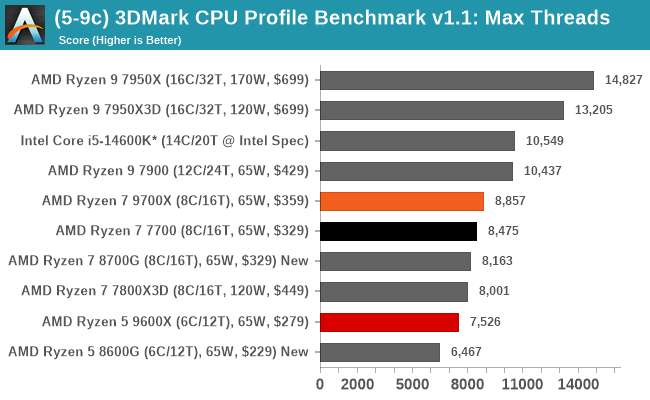
In the Y-cruncher single-threaded Pi calculation, Zen 5 is streets ahead of the completion, as the full 512-bit data path for AVX-512 instructions opens up some of that untapped raw performance. On the other hand, without the AVX-512, or in highly multi-threaded scenarios, both the Ryzen 7 9700X and Ryzen 5 9600X compete with the rest of the chips on test at an even keel.
CPU Benchmark Performance: AI Performance
As technology progresses at a breakneck pace, so do the demands of modern applications and workloads. As artificial intelligence (AI) and machine learning (ML) become increasingly intertwined with our daily computational tasks, it's paramount that our reviews evolve in tandem. To this end, we have AI and inferencing benchmarks in our CPU test suite for 2024.
Traditionally, CPU benchmarks have focused on various tasks, from arithmetic calculations to multimedia processing. However, with AI algorithms now driving features within some applications, from voice recognition to real-time data analysis, it's crucial to understand how modern processors handle these specific workloads. This is where our newly incorporated benchmarks come into play.
Given makers such as AMD with Ryzen AI, with multiple iterations including the XDNA 2 NPU within the Ryzen AI 9 HX 370, and Intel with their Meteor Lake mobile platform featuring AI-driven hardware, aptly named Intel AI Boost within the silicon, AI, and inferencing benchmarks will be a mainstay in our test suite as we go further into 2024 and beyond. While there's currently no defacto benchmark for AI at the moment, we've compiled a couple of different benchmarks to gauge performance.
It's also worth noting that desktop processors don't really utilize NPUs, so all of the grunt in the below benchmarks is done using the CPU.
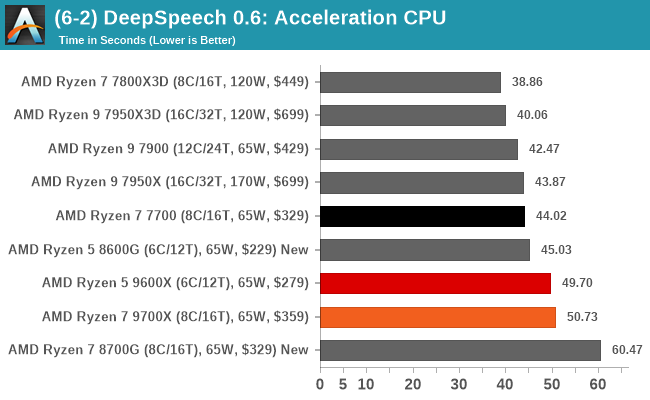
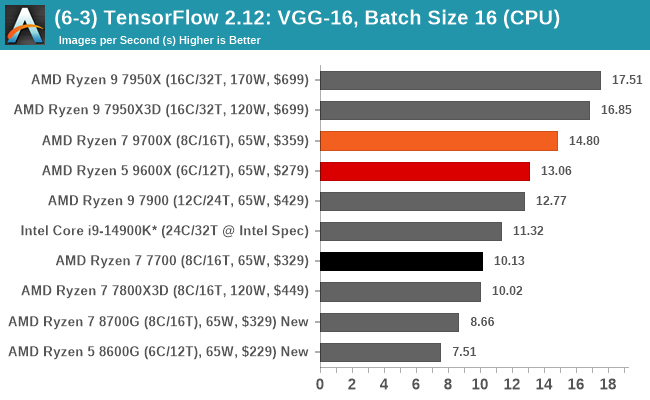
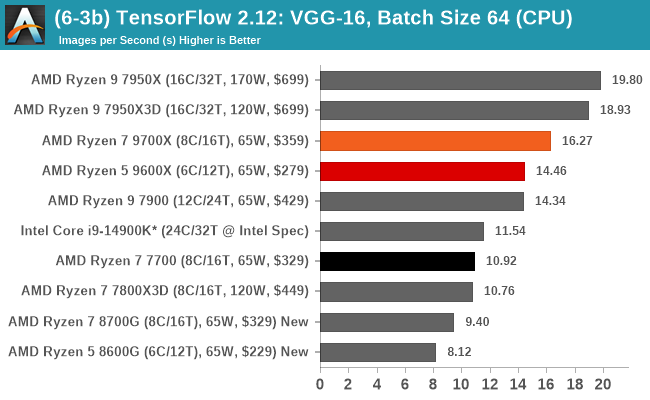

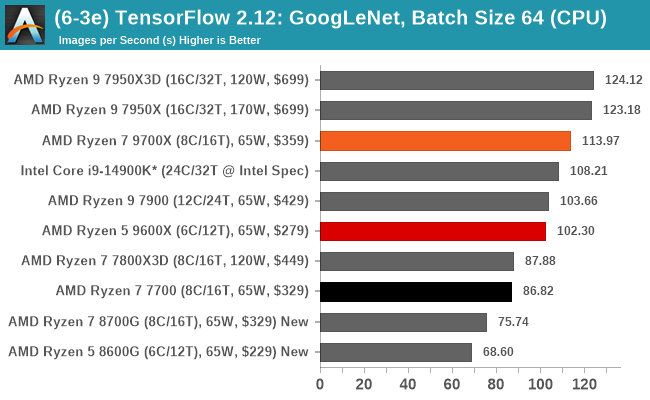
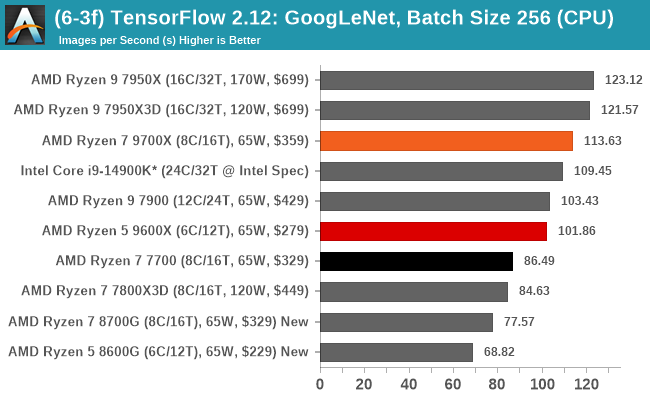
As we've previously stated, all of the AI benchmarks and models used use the CPU to do all the grunt work. In our DeepSpeech Mozilla-based speech-to-text engine, Zen 5 doesn't really do much against the competition, Although in TensorFlow with both GoogLeNet and VGG-16 models, Zen 5 is very competitive.
Gaming Performance: 720p
The reason we test games in CPU reviews at lower resolutions such as 720p and below is simple; titles are more likely to be CPU bound than they are GPU bound at lower resolutions. This means there are more frames for the processor to process as opposed to the graphics card doing the majority of the heavy lifting.
There are some variances where some games will still use graphical power, but not as much CPU grunt at these smaller resolutions, and this is where we can show where CPU limitations lie in terms of gaming.
Note: We are currently benchmarking more processors as we speak, so we will update these graphs as the results come in. It may take hours or days, but more data points are coming.
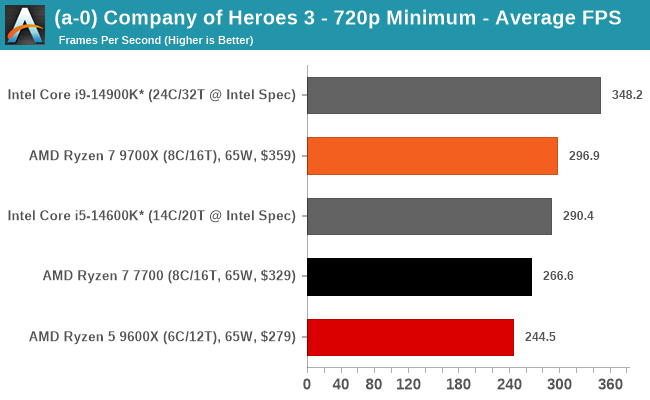 |
|
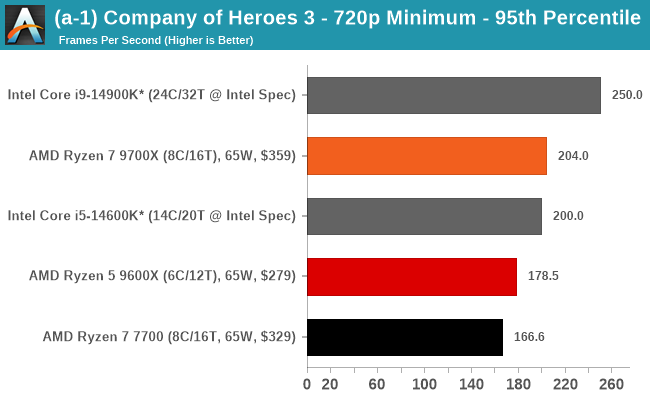

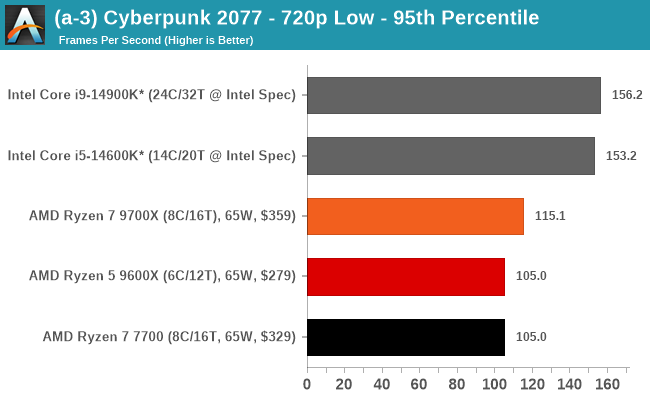
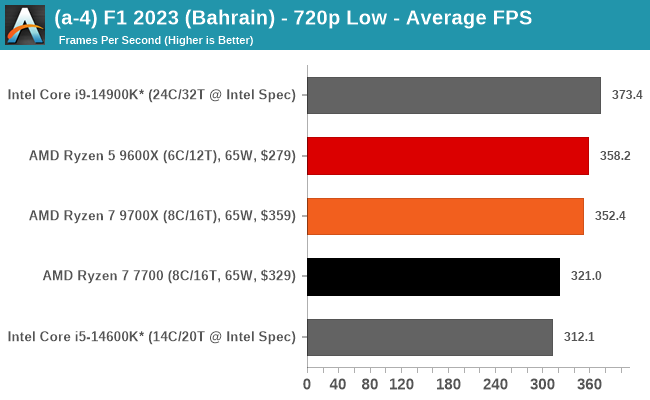
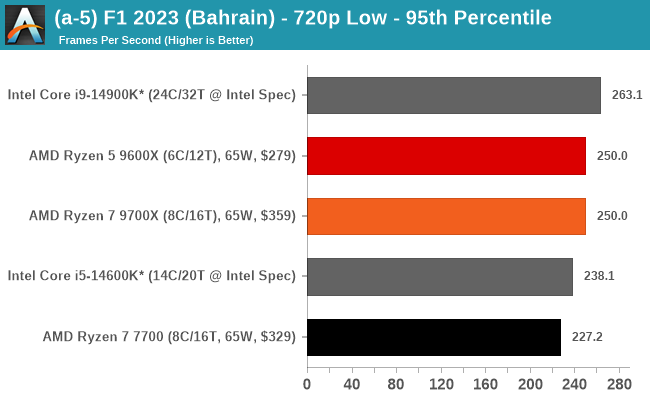
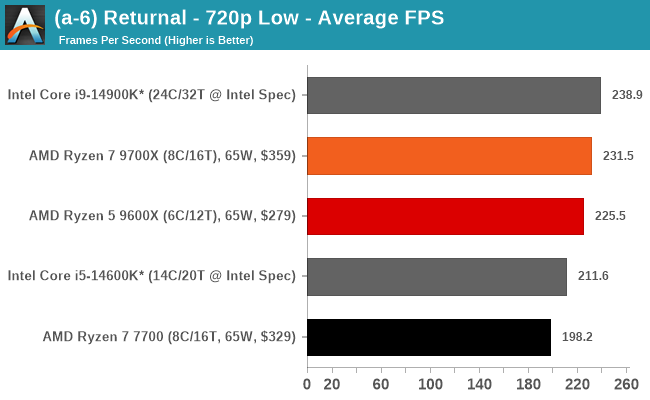

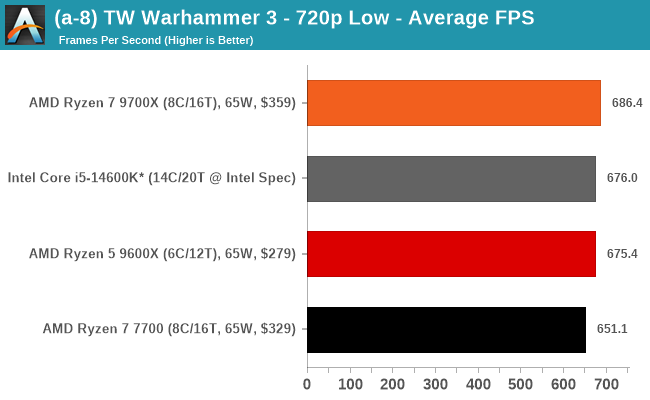

At lower resolutions, such as 720p, the CPU has more onus than the graphics. We can see that while the Zen 5 laden Ryzen 7 9700X does outperform the previous Ryzen 7 7700 in the majority of the suite at 720p, there's certainly plenty of performance when you compare it to how close things are to the Intel Core i9-14900K, albeit at Intel's recommended specifications and not at the whim of overzealous motherboards.
Gaming Performance: 1080p
Moving along, here's a look at a more balanced gaming scenario, running games at 1080p with maximum image quality.
Note: We are currently benchmarking more processors as we speak, so we will update these graphs as the results come in. It may take hours or days, but more data points are coming.

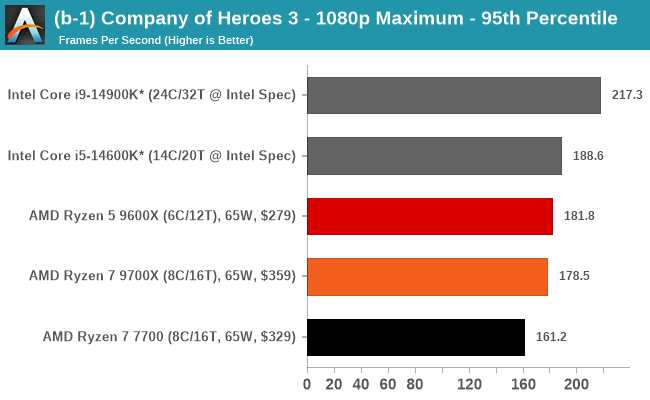
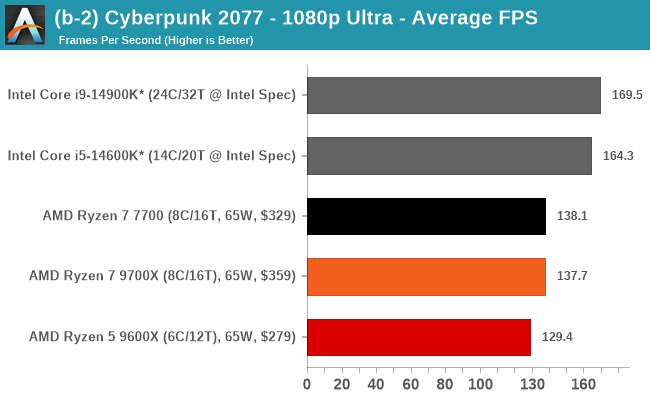
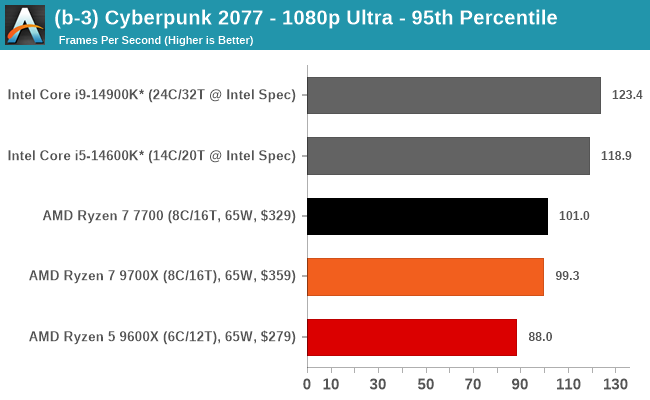
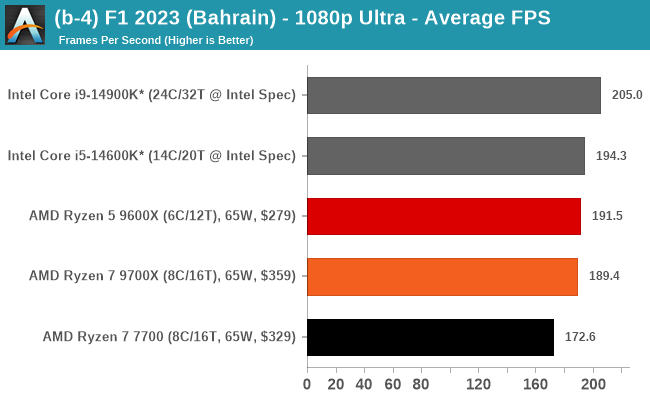
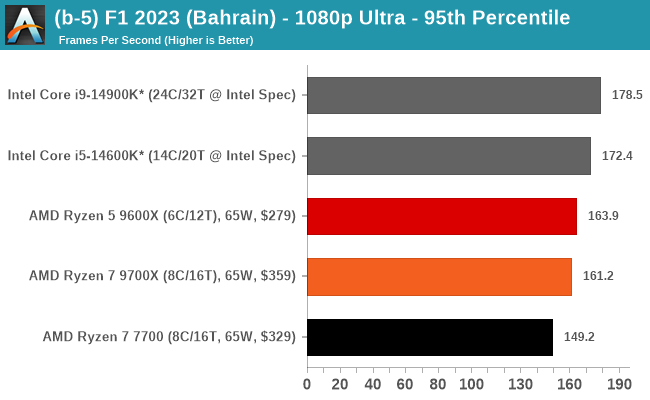
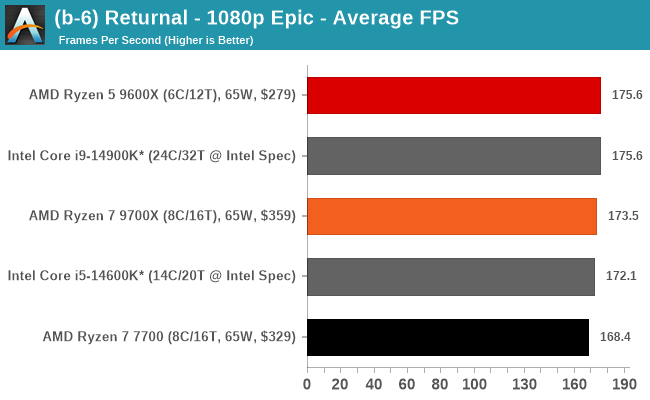
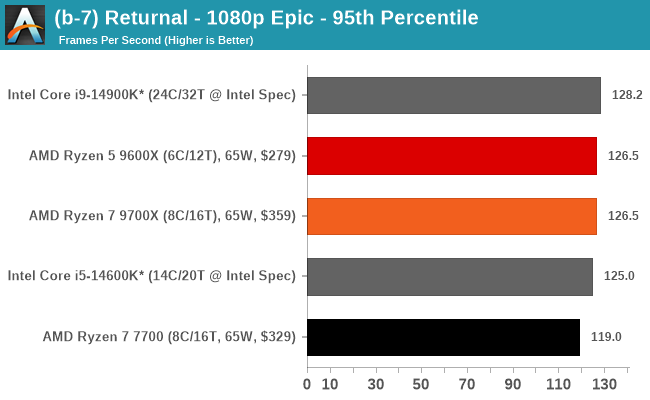
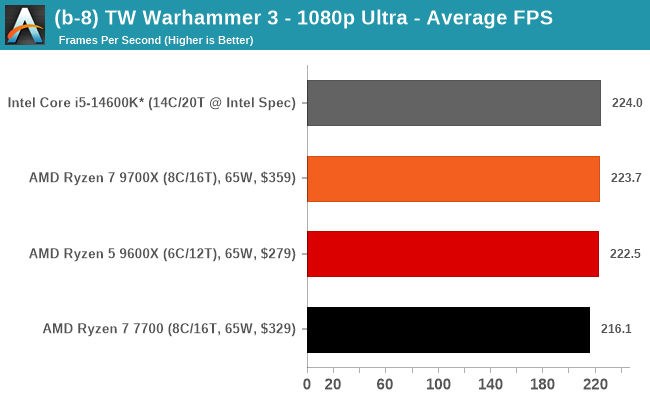
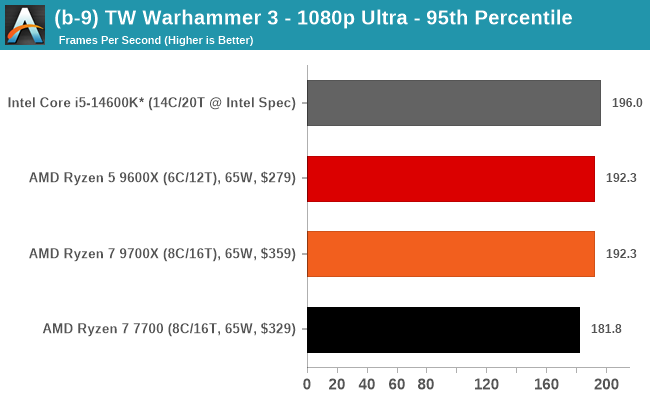
Moving onto performance at 1080p with our MSI GeForce RTX 4080 Gaming X graphics card, the chips become a lot more competitive. In Company of Heroes 3, we see this title favoring the Core i9-14900K with its higher core count, faster cores, and, ultimately, more power available under the hood. Overall the Ryzen 7 9700X and Ryzen 5 9600X remain competitive.
Gaming Performance: 4K
Last, we have our 4K gaming results.
Note: We are currently benchmarking more processors as we speak, so we will update these graphs as the results come in. It may take hours or days, but more data points are coming.
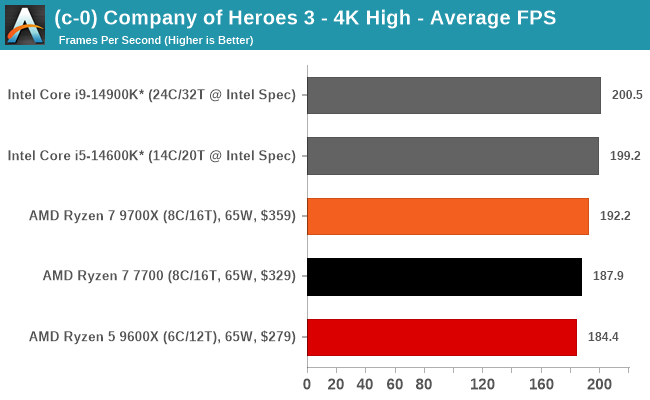 \
\

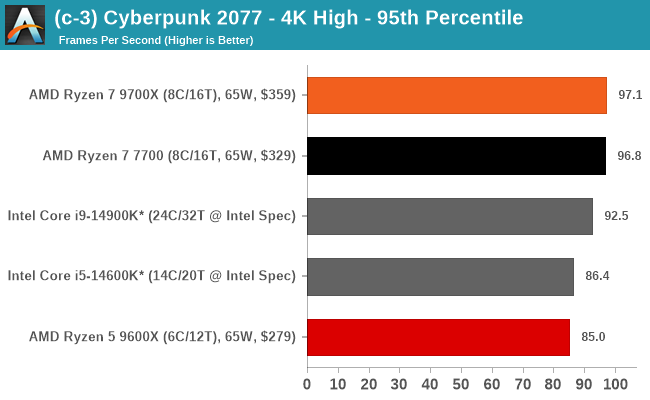
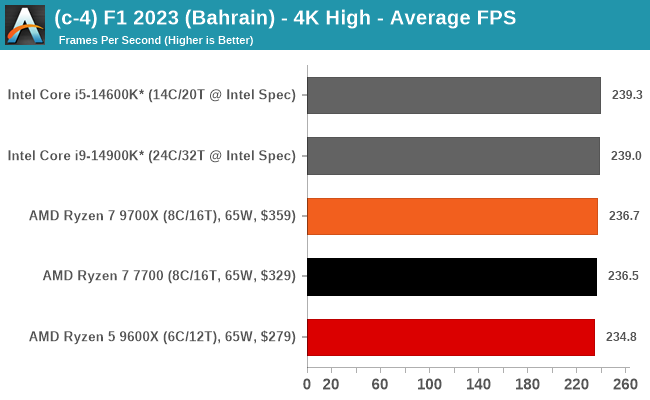
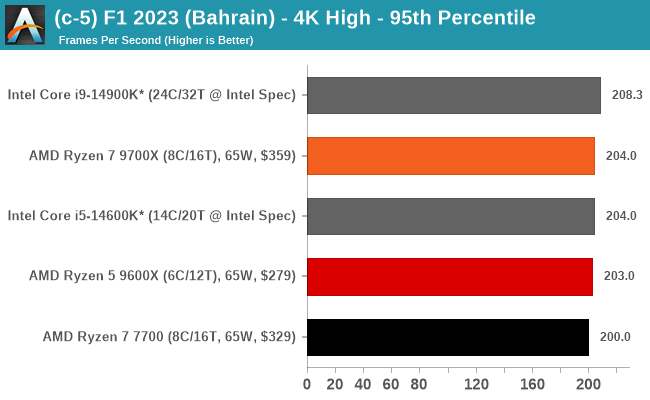
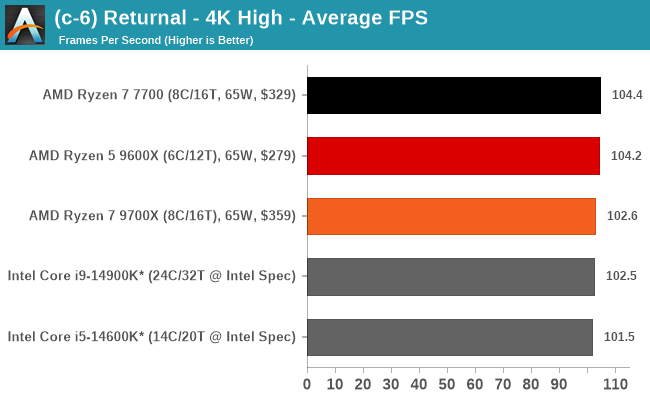
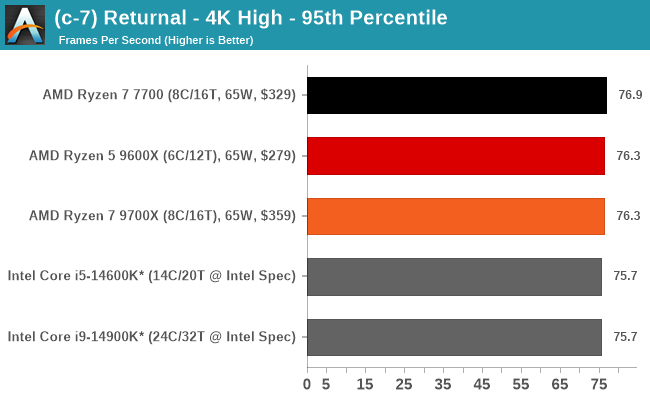


Conclusion
Since the good old days, or back in 2017, AMD debuted their 1st generation of Ryzen processors on their original Zen microarchitecture, and ever since, there has been no looking back. Back when Intel was dominant in the consumer market, fast forwarding to today, and the competition has never been so hot between the two silicon goliaths. Something that's just as peculiar as it is interesting, though, is that today isn't the first Zen 5 product AMD has launched, which goes the grain from everything we've seen from a Ryzen launch so far.
AMD opened the Zen 5 jar with their Ryzen AI 300 mobile series, which we reviewed last week via the Ryzen AI 9 HX 370 mobile SoC. While AMD combines full-fat Zen 5 cores with the more compact Zen 5c cores, also another first for AMD on a new architecture launch day, the Ryzen 9000 series for desktop is finally here for those looking for something with more oomph, albeit static. Again, AMD has gone against the grain once again, and instead of launching their best first, AMD has opted to stagger the launch of the Ryzen 9000 and gave us all the two bottom SKUs in the quartet announced so far.
So, launching today are the AMD Ryzen 7 9700X (8C/16T) and the Ryzen 5 9600X (6C/12T), which occupy the more affordable market segment, with the 9700X costing $359 and the 9600X at the cheaper price of $279. Not only is AMD's Zen 5 chips cheaper than their corresponding SKUs compared to 2022's Zen 4 and Ryzen 7000 series SKUs. That's good for consumers, as we've seen rising hardware prices consistently year on year. Especially in motherboards, where the mid-range in 2015 used to be $200, that would barely get you an entry-level X670E model today, with prices up to and including $800+ for a flagship desktop model.
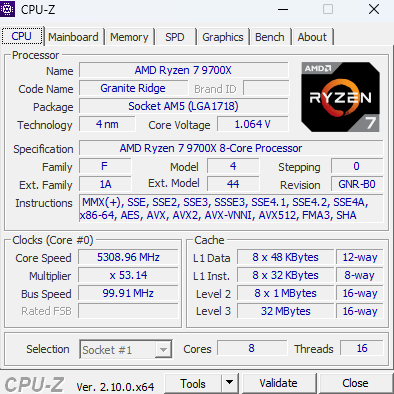
The AMD Ryzen 7 9700X, as seen in CPU-Z
Anyway, so not only does Zen 5 bring cheaper chips to consumers, but it also brings equivalent specifications with a lower TDP. However, when you factor in Power Package Tracking (PPT) from the AM5 CPU socket, the 65 W TDP translates into more like 88-90 W, so that's another dagger in the relevance of what value is placed in what the TDP is. It does have to be said, though, even at under 100 W, AMD's previous examples, such as Zen 4, have proved that they can hang with the best, even when dialing down the power output.
So while we're still waiting for the big guns of AMD's Zen 5 based Ryzen 9000 series, the Ryzen 9 9950X, which is the 16C/32T flagship, and the slightly lesser Ryzen 9 9900X, which has 12C/24T, how does Zen 5 stack up in terms of performance, which is the thing people typically care about when purchasing a new processor; price is the other main characteristic people look for. Let's dive into some analysis:
AMD Ryzen 7 9700X & Ryzen 5 9600X: Compute Analysis
Much of the focus isn't just on how well the Zen 5 on desktop performs but how much of an improvement it presents compared to its predecessor, Zen 4, and the Ryzen 7000 series. There are two primary elements to consider when judging the performance going to Zen 5 from Zen 4: single-threaded performance and any associated uplifts, multi-threaded performance because that's where the heavy lifting with intense workloads is done, and power efficiency. Power efficiency is more of a comparison to Intel's offerings in the same tier, so for the Ryzen 7 9700X with an MSRP of $359, this puts it in the realm of the Intel Core i5-14600K, which is currently available at Amazon for $300. This also means that the Ryzen 5 9600X, at $279, is also in the same $250-300 price range as the i5-14600K is also.

Looking at the performance difference between the Ryzen 7 9700X and the Ryzen 7 7700 in Cinebench R23, in the single-threaded test, the 9700X is around 23% ahead, which is a really nice uplift in single-threaded IPC performance. Interestingly, the Intel Core i9-14900K with Intel's recommended settings using the Extreme Power Delivery spec (253 W) actually hit as high as 290 W in our max power test. In Cinebench R23, in the single-threaded test, it managed to stay ahead of Zen 5. Whether that remains the case when AMD launches the other two SKUs, the flagship Ryzen 9 9950X (16C/32T) and the Ryzen 9 9900X (12C/24), is currently anyone's guess.

However, in Maxon's latest Cinebench 2024 multi-threaded test, the Ryzen 7 9700X is only around 5.5% faster than the Ryzen 7 7700. Adding the cheaper Intel Core i5-14600K into the equation, which we tested using Intel's recommended settings after the furor surrounding the instability issues users have been facing with Intel's 13th and 14th Gen Core series processors. Intel has even since extended the warranty on both families by two years to help mitigate concerns. The Core i5-14600K does have more cores (14C/20T vs 8C/16T), so Intel does have an advantage here in multi-threaded tests, which when you factor in the Intel chip is pulling double the power than the Ryzen 7 9700X, shows that there's certainly efficiency within the heart of the Zen 5 core.

Back to single-threaded performance, and in Cinebench 2024 ST, the Ryzen 7 9700X is ahead again by around 23.5% over its older counterpart. Granted, it's the non-X version, but both chips have a TDP of 65 W, so it's a good comparison of where Zen 5 is at; it definitely has good single-threaded gains over the previous Zen 4 cores, but in multi-threaded scenarios, Zen 5 isn't as potent as some may have hoped. The Ryzen 7 9700X even marginally beat the Core i9-14900K, which has been limited to around 290 W in terms of maximum power; this is a huge contrast to the 378 W our Core i9-14900k pulled in our original review.

One of the key improvements on Zen 5 is a full 512-bit data path for AVX-512 workloads, and in instances where this can be leveraged in a workload or application, it does offer a substantial performance increase over Zen 4 core-for-core. The Ryzen 7 9700X is also within touching distance of the Ryzen 9 7900, although the 16C/32T Zen 4 chips, the Ryzen 9 7950X, and the 3D V-Cache laden Ryzen 9 7950X3D still dominate despite featuring two 256-bit data paths to funnel through AVX instructions.

Perhaps the biggest win of all for the two Zen 5 chips over the competition is in y-cruncher, where both the full 512-bit data path really shows its worth. AMD did make a bold claim that Zen 5 has 16% higher IPC performance than Zen 4, but this is factoring in these kinds of situations where the full utility of a 512-bit data path and AVX-512 instructions come together like peanut butter and jelly.

In gaming, especially when looking at lower resolutions such as 720p, we typically see more CPU-limited situations than CPU-limited situations. In Company of Heroes 3, the Intel Core i9-14900K shows its dominance as the bigger and better CPU. Interestingly, we see the Ryzen 7 9700X outperform the competition Core i5-14600K, which, despite having more cores and threads, is a direct competitor in terms of price.

At higher resolutions, such as 4K, things are more GPU bound, and we see all of the chips tested so far on our new game suite compete closely within a fine margin of each other despite the line-up ranging from 6C/12T all the way up to 24C/32T. Even then, in Returnal at 4K, the predecessor is on top by just 0.2 frames per second, which, depending on the runs, could have gone either way; that's how close the margins are.
In gaming, it really depends on the title. If it can be utilized and the game itself is optimized for more than 8C, then Intel will certainly come out on top. For the most part, 8 cores are still plenty for gaming; as we can see, when gaming at higher resolutions, such as 4K, the graphics card is certainly much more important.
Final Thoughts: Zen 5 is Cheaper, Faster, And a Taster Before Ryzen 9 Hits
Finally, seeing Zen 5 in action on the desktop and in direct competition to both the predecessors (Zen 4/Ryzen 7000) and even Intel's 14th Gen Core series, it becomes a case of what type of workloads are being undertaken, and of course, power consumption and pricing have to be factored in. As Intel's Core i5-14600K has more cores, it does come out on top in the heavily multi-threaded workloads unless AVX-512 is being utilized somehow, and then it becomes a different story.
As we would expect from a new iteration of AMD's Zen microarchitecture, now into its 5th Generation, and Zen 6 already in the pipeline and emblazoned on the AMD CPU roadmap, AMD doesn't look like it stopping when it comes to serving up Intel some stiff competition. AMD's first two Ryzen 9000 series processors, especially in the certainly excels over Intel's current 14th Gen Core series when factoring in performance per watt, and the underlying Zen 5 architecture has certainly exceeded expectations in the desktop.
In single-threaded tasks, Zen 5 is a clear winner over Zen 4, which we would expect to see given that Zen 5 packs a plethora of architecture improvements and also gets the advantage of being built on a newer process node with TSMC's N4P. In a lower-powered environment, especially in a small form factor chassis or in a conventional desktop where overclocking isn't a concern, AMD's Ryzen 7 9700X at $359 certainly delivers plenty of bang for the buck when compared to Intel.
The caveat is in multi-threaded workloads compared to the previous Zen 4 chips. There just doesn't seem to be a lot of benefit from opting for a Ryzen 7 9700X over the Ryzen 7 7700, even with the former's slight clockspeed advantage. The classic catch with reusing a platform, as in the case with AM5, is that while there's faster CPU cores, there's not much in the way of additional memory bandwidth to help feed those CPU cores. AMD's performance uplifts largely pan out for lightly-threaded workloads, but we aren't seeing as large of gains for heavily threaded tasks.
Still, we are talking about 65 Watt chips. Or rather, more like 90 Watt chips once you factor in AMD's Package Power Tracking mechanisms. So TDPs may be a factor here, and it'll be something to look at in the future. As an aside, I still believe it would have been more advantageous for AMD to market the processors at 90 W with the PPT value, but I digress...
Overall, Zen 5's performance in single-threaded workloads, especially in rendering, certainly takes things up a notch. And from an architectural perspective, Zen 5 is clearly an improvement over Zen 4 in virtually every way possible. Now we're just waiting to see what Zen 5 can do in its fastest desktop configurations, with the Ryzen 9 9950X (16C/32T) and the Ryzen 9 9900X (12C/24) set to launch next week. So stay tuned!

